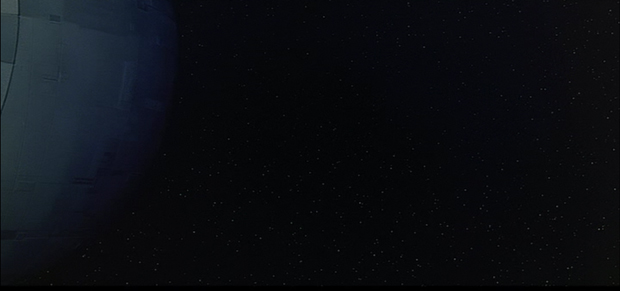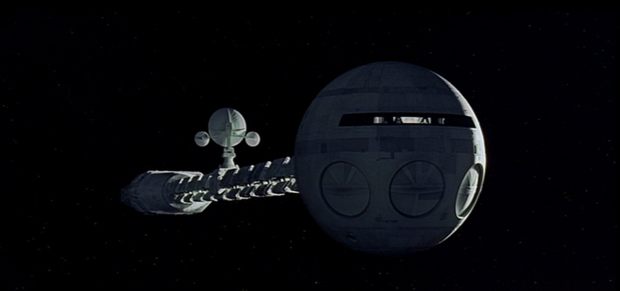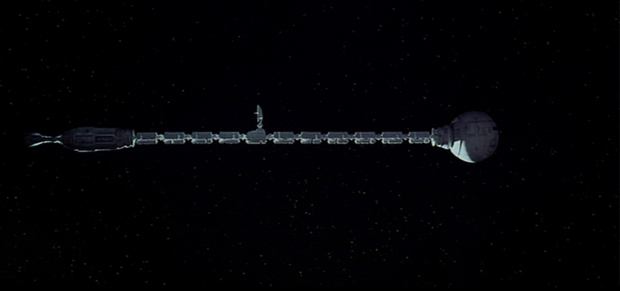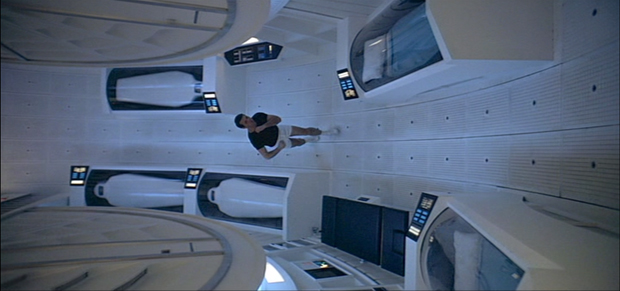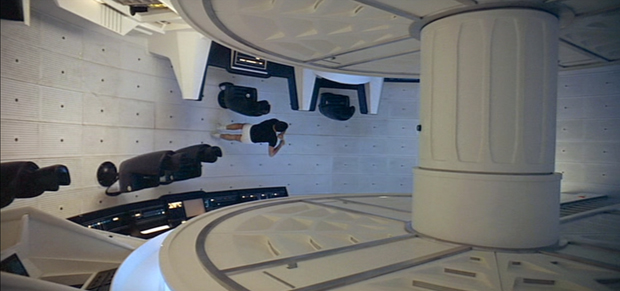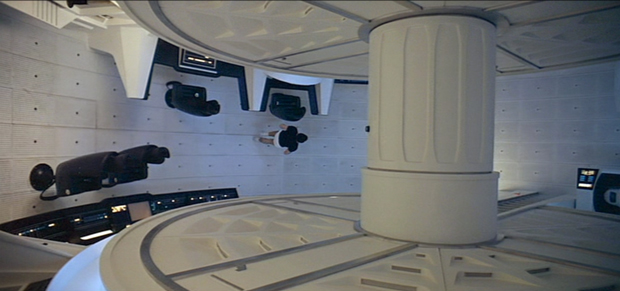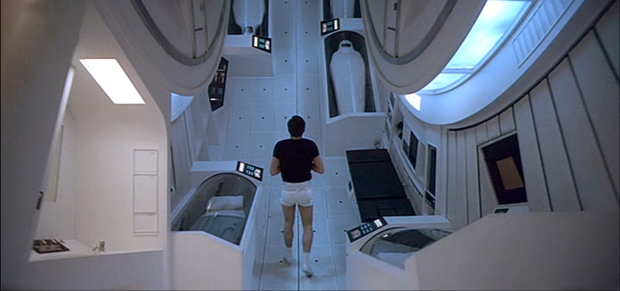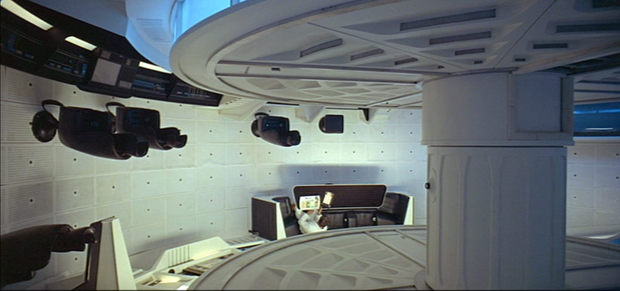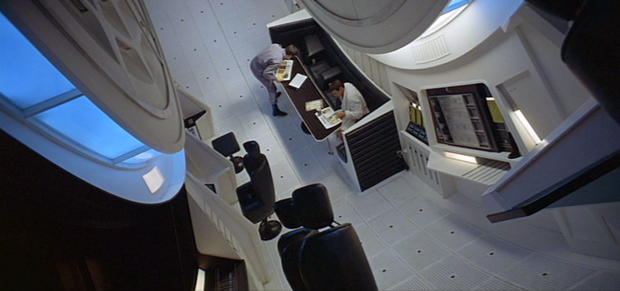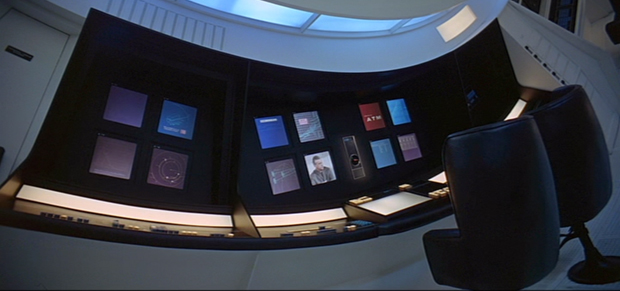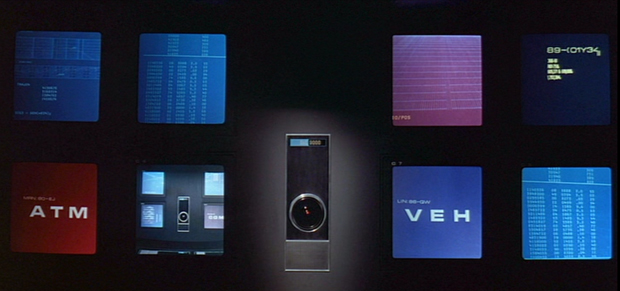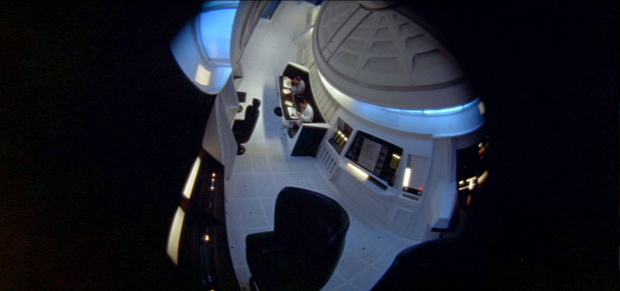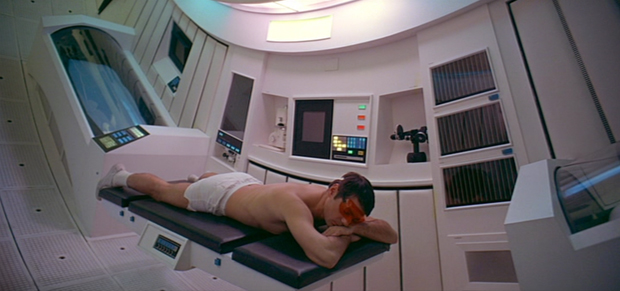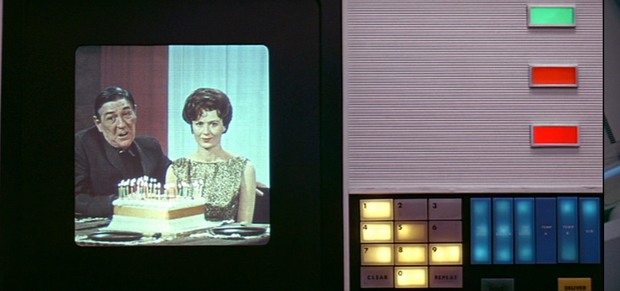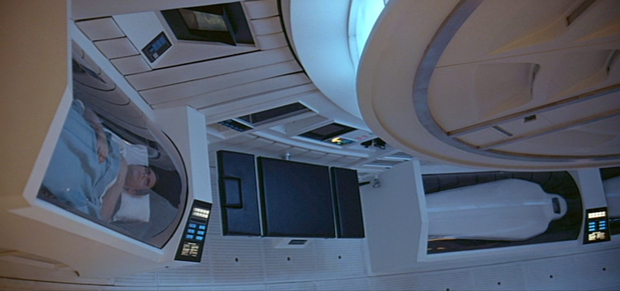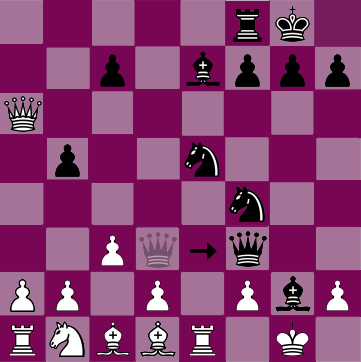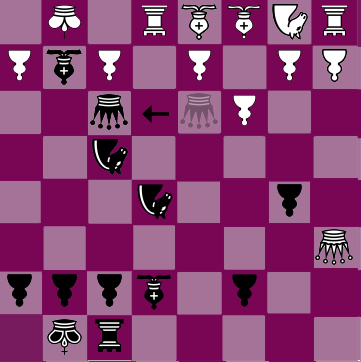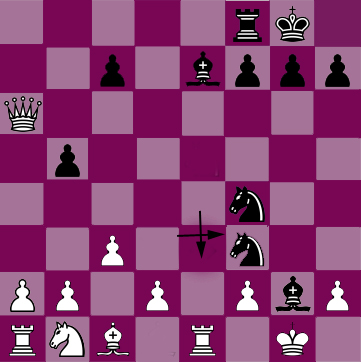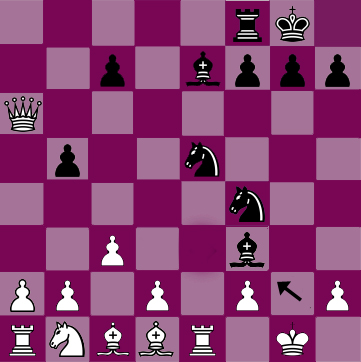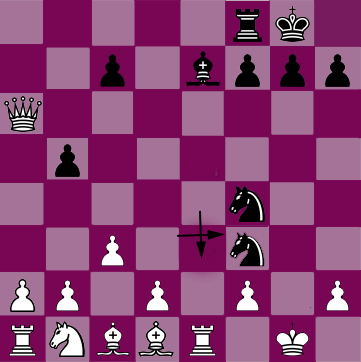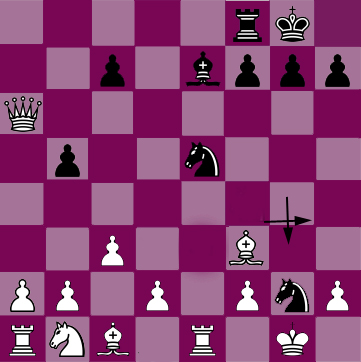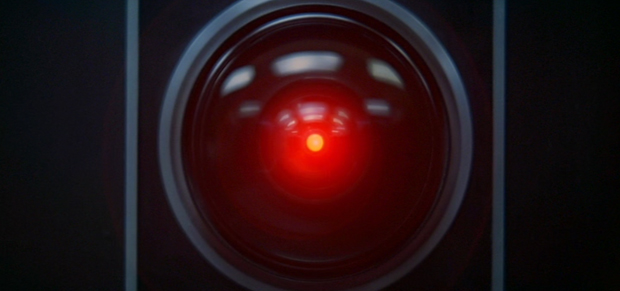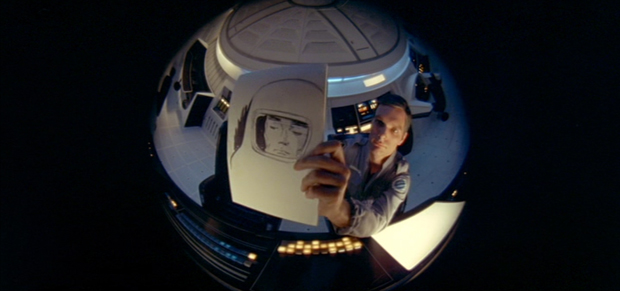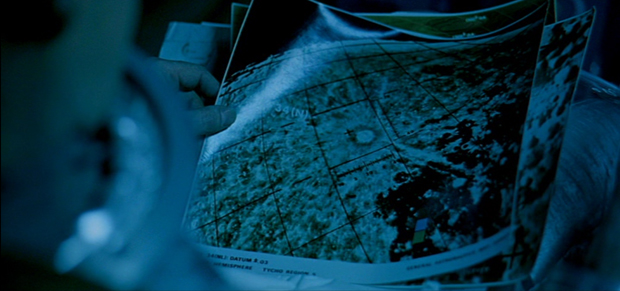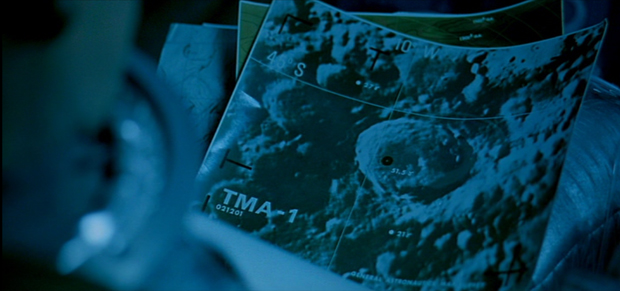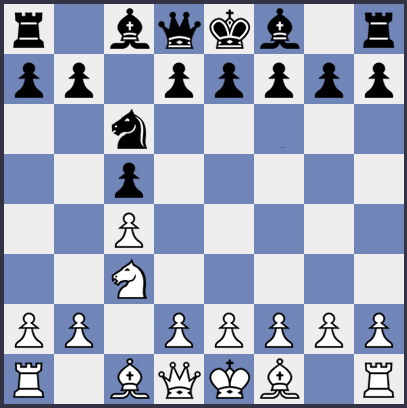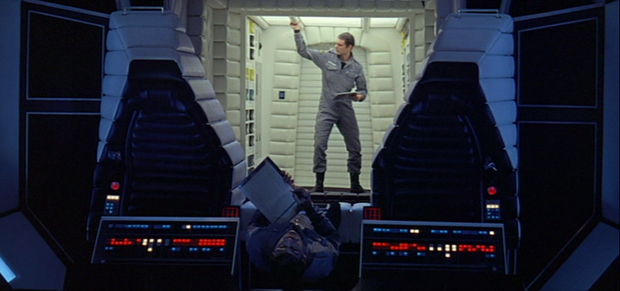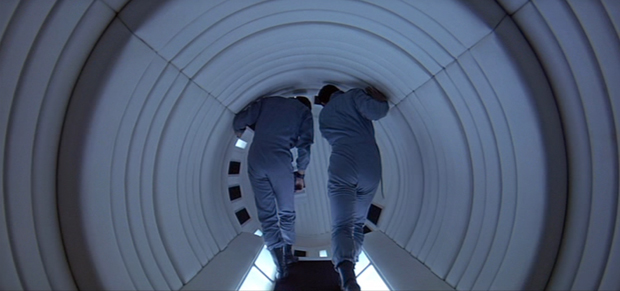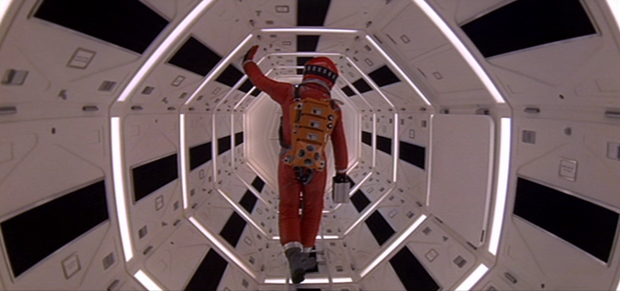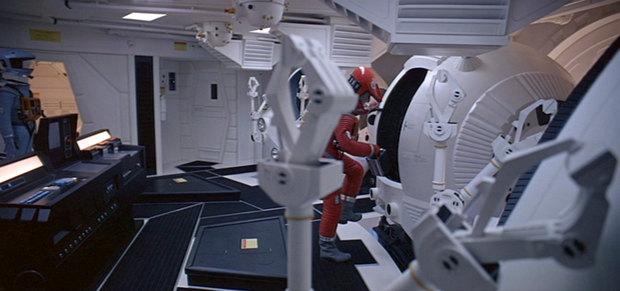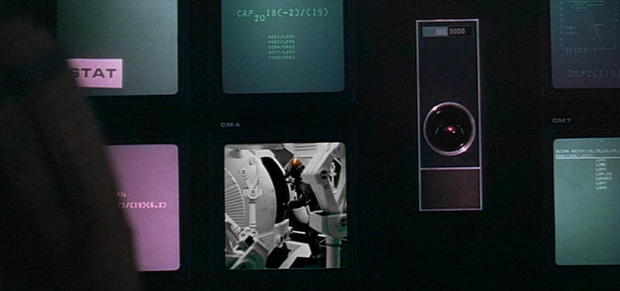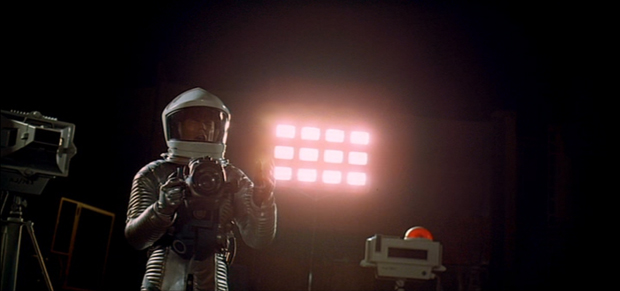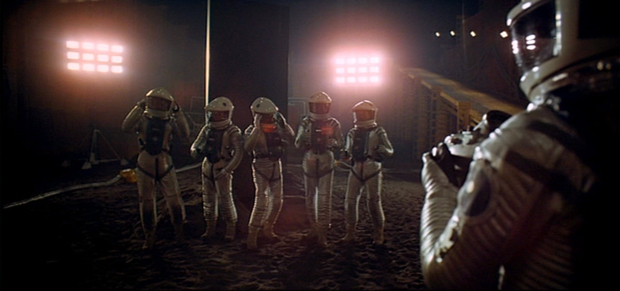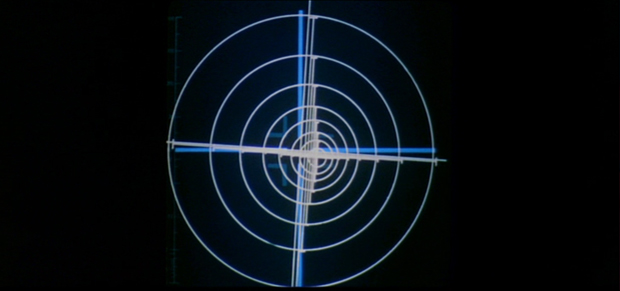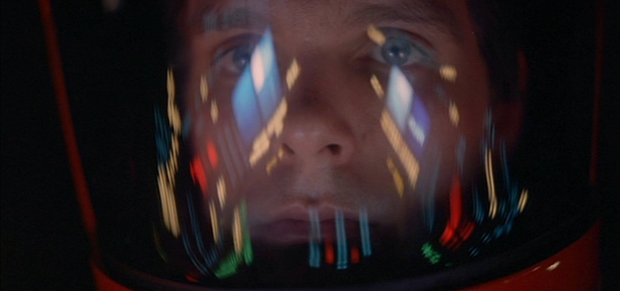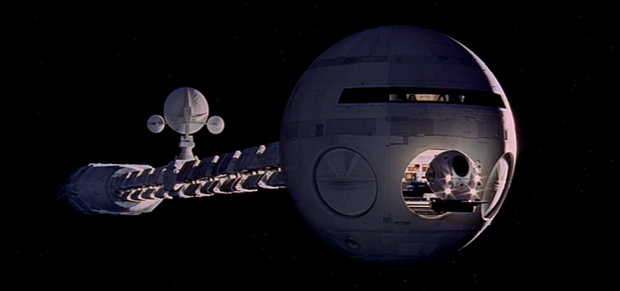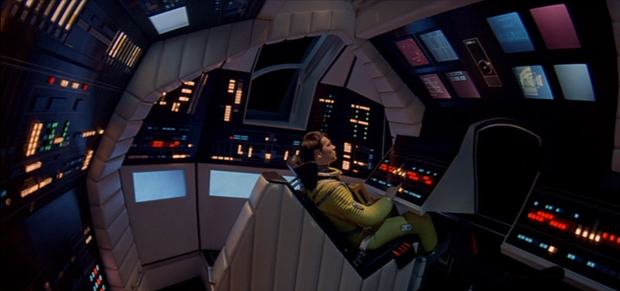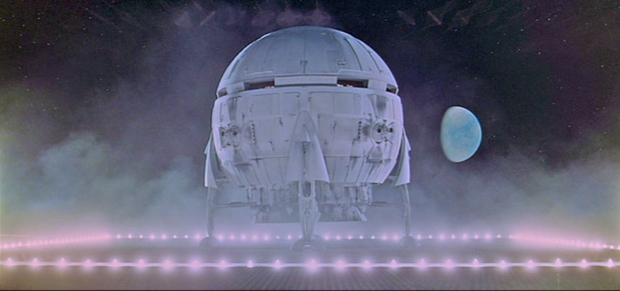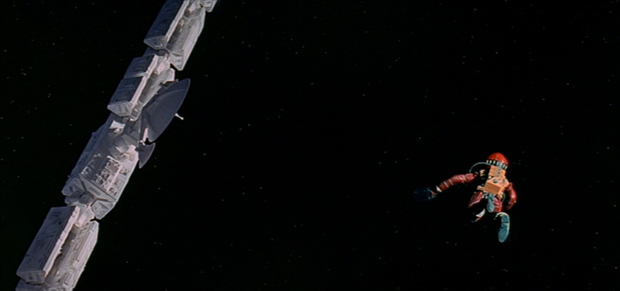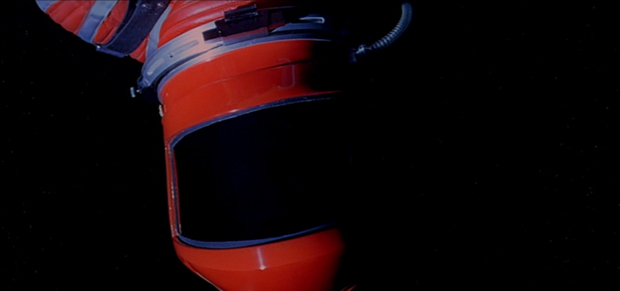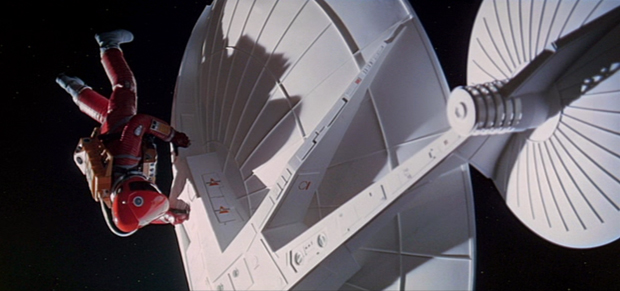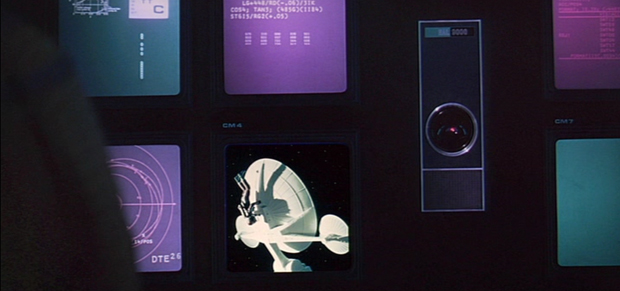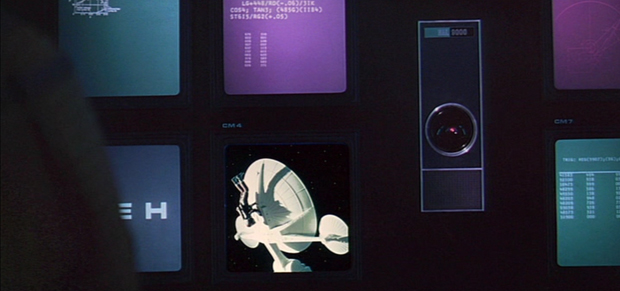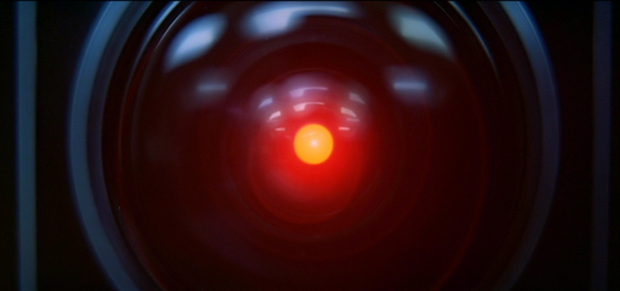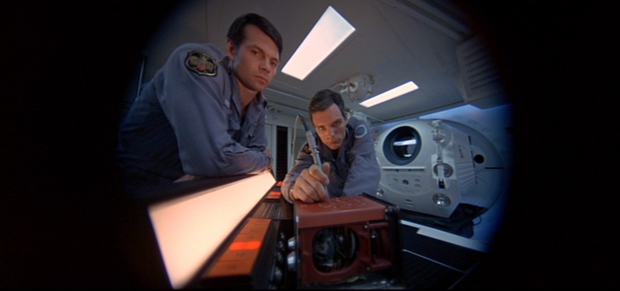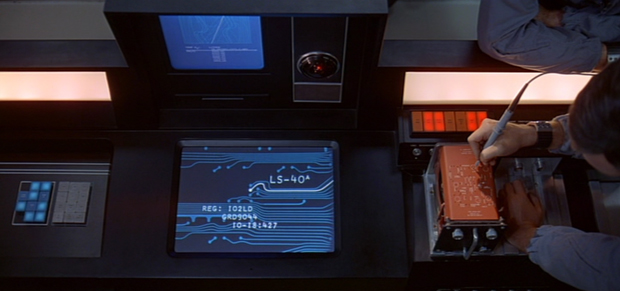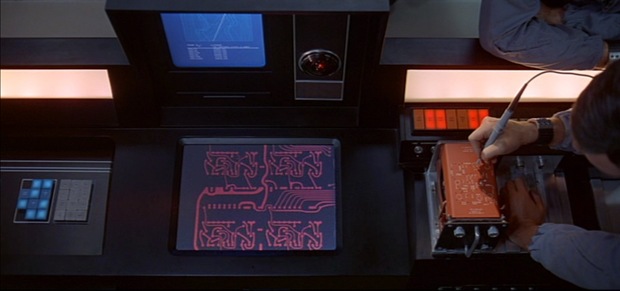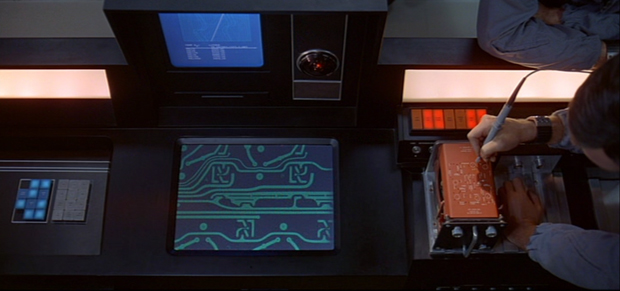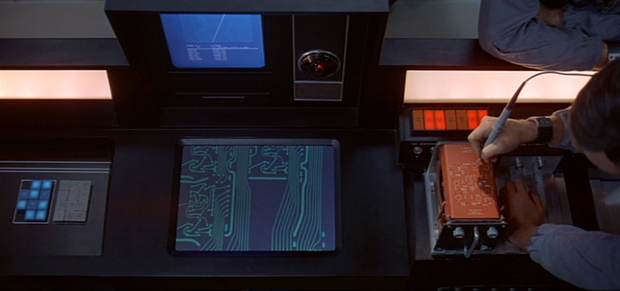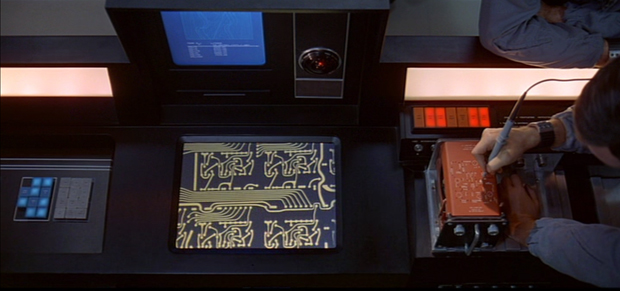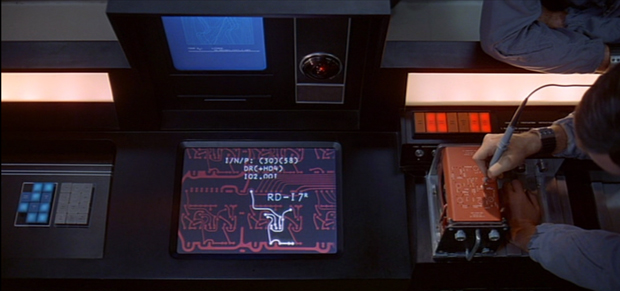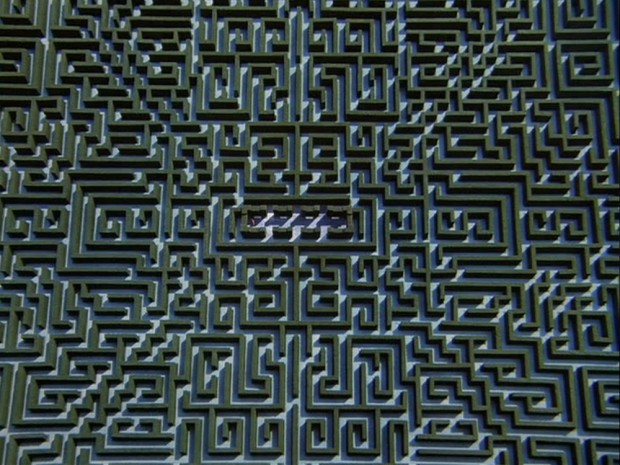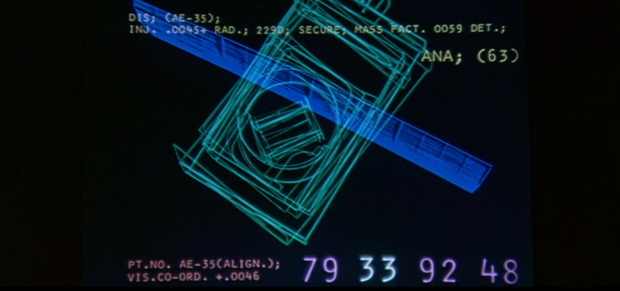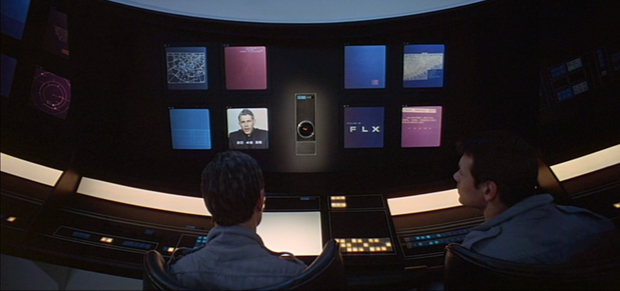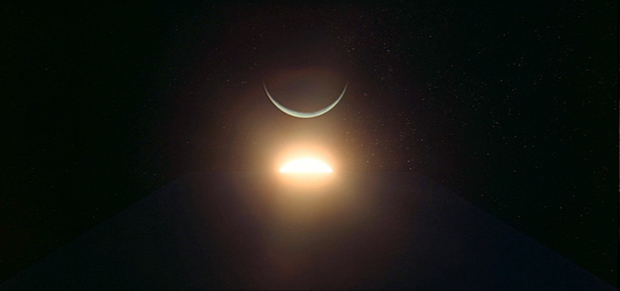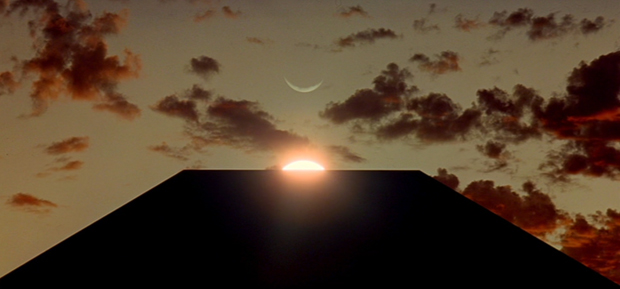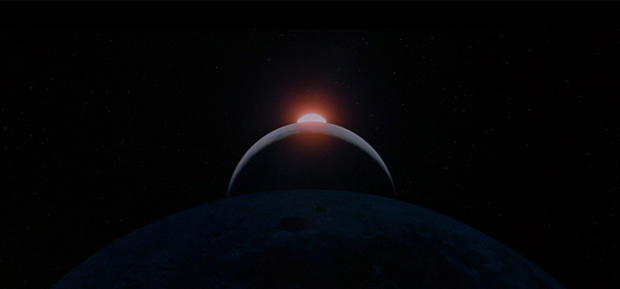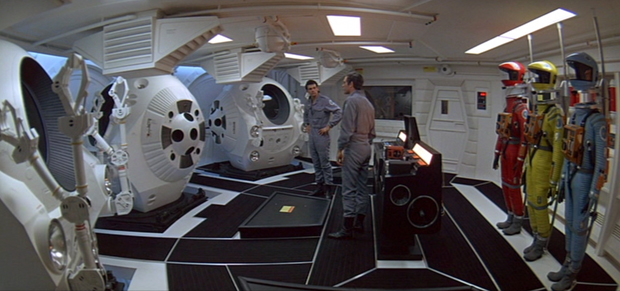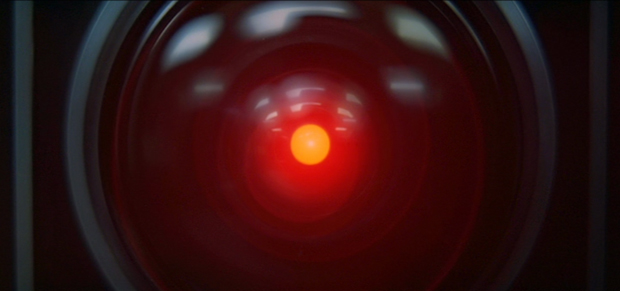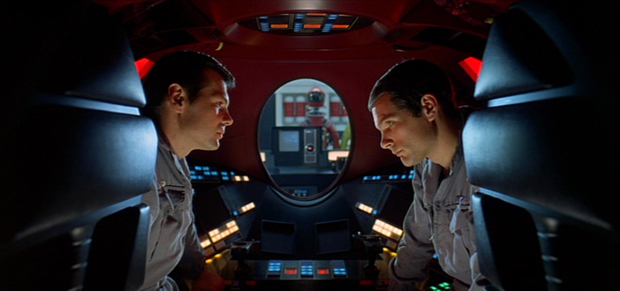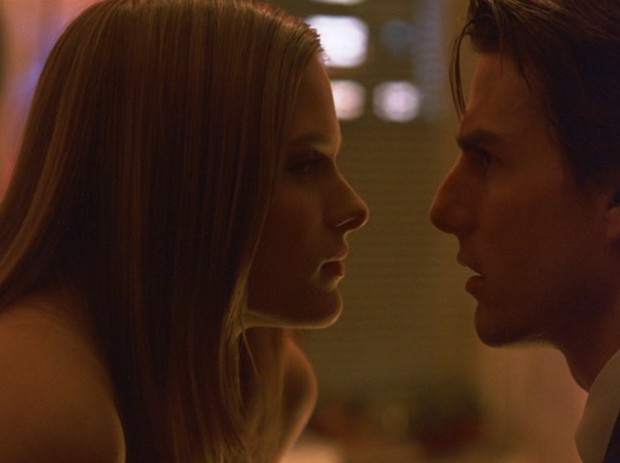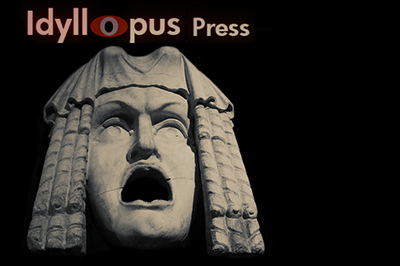STANLEY KUBRICK'S FILM

Go to TOC for this film ( (which has also a statement on purpose and manner of analysis and a disclaimer as to caveat emptor and my knowing anything authoritatively, which I do not, but I do try to not know earnestly, with some discretion, and considerable thought).
PART THREE
TOC and Supplemental Posts | Part 1 | Part 2 | Part 3 | Part 4 | Part 5 | Films Home
LINKS TO SECTIONS OF THE ANALYSIS ON THIS PAGE:
Some subjects/subheadings covered:
Gayane and a Disorienting Introduction to the Ship, Shots 223 through 229
Khachaturain's Adagio from the 1942 Gayane ballet. Orion and the killing of the wild beasts. Slaying of Orion after the healing of his eyesight. Dave as the intellectual where Frank expresses concerns of the body (exercise). Their twin aspects. Gilgamesh and Enkidu. Discovery One as a nervous system (spine and skull). Flips of orientation during the exercise scene. In shot 227, not only is the camera now following behind Frank instead of preceding him at the beginning, Frank is running in the opposite direction. Furthermore, not only is Frank running in the opposite direction, Kubrick has flipped the orientation of the film horizontally. We don't notice the change because the shots of Frank open with him running in an orientation 90 degrees turned from a normal standing view. I clearly outline the process in the analysis (an easy way to keep track is by the part in Frank's hair).
The Role of the Photographer in an Interview with HAL, Poole, and Dave, and a Great Big Question Concerning HAL, Shots 120 through 256
Who is doing the filming for the interview on the ship--which I consider as we have four different angles. The reverse image shots of the hibernators. Parallels between HAL and the photographer. The headrests and their disappearance. Changes in the shots of HAL's eye. How Dave and Frank watch slightly different versions of the interview.
A Second Birthday, Shots 257 through 263
236 in 2001 and 236 in The Shining. During the talk with Frank's parents, the views of the instead empty tanning bed and Dave asleep in his pod. The one shot of a nature scene on earth above Dave's pod. The 90 degree rise of the tanning bed's head and its seeming relationship to Frank's disappearance. How we have the same with Danny's disappearance in the maze in The Shining. Frank's orange sunglasses and HAL.
Chess with Poole (Alternate Moves and Simultaneous Views), Shot 264
The number 64 sometimes accompanies Kubrick's chess games and boxing matches. How HAL's chess game with Dave plays out, shown with descriptive images. 3 ways the chess game can play out due the language used. (Kubrick sometimes gives 3 perspectives, such as of the happenings in Room 237.) Only one game results in a checkmate but all involve the 90 degree diagonal jump of the knight. The capture of Charlotte's queen in Lolita. The 2001 chess game based on Roesch vs. Willi Schlage in 1910. Considerataions on the bishop. The horizontal flip mirrorings, dualism. HAL's ability to see both sides at once, which is his error, that he expresses the chess board from Frank's POV.
Sketching with Dave, an Oracle from HAL (whose Eye is not What it Seems to be) and More Chess, Shots 265 through 287
HAL takes after Symslov (named after a chess master) who had identically apologized for being too inquisitive before posing a question. As with Floyd, Dave replies he doesn't know what (HAL) means. The occlusion in HAL's eye. HAL's programming and duplicity. The flatness of Dave. How the communication "dish" is an evolution of the moon crater which was an evolution of the water hole. HAL's rotation of the AE35 unit (simulation) so it is turned at a 90 degree angle, and as it finishes the turn the target aspect disappears. Possible connection of the Alpha Echo 35 to the ECO codes that are a classification for chess opening moves. ECO A35 as a symmetrical opening move. The picture of the Tycho Magnetic Anomaly suggests chess with its suggestion of 64 squares.
Frank and Dave at a 90 degree angle from one another. The growing similarity of Frank and Dave.
Dave's Space Walk, Shots 291 through 333
Comparing the audience's view of Dave entering the pod in 293 with Frank's view in shot 294, nearly identical but reversed. Horizontal flip. Dave's horizontal flip in shot 310 during the EVA then return to "appropriate" orientation.
AE 35 and its Maze Aspects
In Error, Shots 334 through 346
A Hidden Convergence and Various Aspects of Taurus. 346, an unusual shot of HAL's eye in which we see a hidden convergence, HAL's eye as the sun and a crescent above it. Taurus, the vernal equinox, and the Cretan Bull. Taurus containing the red star of Aldebaran. Taurus and Pesach Shani, the second passover.
The Theme of Crises in Communication in Kubrick's Films, Shots 347 through 360
Comparing crises in communication in 2001 to Dr. Strangelove and The Shining and Eyes Wide Shut. The final shot before intermission is 360 so we have a full revolution. However it may instead be 361, for the final shot of the "orgy" scene in Eyes Wide Shut is 361 and is paired with the idea that there is "no turning back". So 361 would be surpassing the point of turning back. We may have the same here. We have the opportunity to move this to be shot 360 back at shot 105 when the bone, traveling upward, changes direction in seeming midshot. In other films I have handled such breaks as two shots (see shots 225 and 226 in Killer's Kiss and shots 319 and 320 in The Killing for examples).
HAL's Error
THE ORACLE
GAYANE AND A DISORIENTING INTRODUCTION TO THE SHIP
SKIP ALL THIS AND TAKE ME TO THE TL;DR WRAP-UP AT THE END OF THE PAGE.
223 The black vault of the star lit sky. (54:39)
JUPITER MISSION, 18 MONTHS LATER appears on the screen. Khachaturain's adagio from the 1942 Gayane ballet plays.
The story of the ballet involves a woman who works on a kolkhoz, a Soviet Union collective farm, whose husband is a sluggard and crook. She scolds him and he subsequently becomes jealous of her attentions to Kazakov, a commander of the Soviet frontier guard and the quintissential good guy. Her husband, a decidedly bad guy, eventually tries to kill her brother, threatens to throw their child over a cliff, and then stabs her, whereupon she is rescued by good guy Kazakov. Her husband is brought to justice and she marries Kazakov.
The name Gayane is thought to perhaps be related to the Greek Gaia, or earth goddess, the mother of all.
Orion had been the name of the first vessel carrying Heywood from Earth to Space Station 5. In the myth of Orion, the hunter had sworn to kill all the wild beasts. In one of the variations of the myth, Gaia, the great mother, sent a scorpion that killed Orion by stinging his heel and thus prevented the great hunter from realizing this destruction.
The giant, Orion, becomes blended with the story of Enkidu, another wild man, who was civilized by his association with the sacred prostitute, Shamhat, just as in some stories Orion was civilized by the sacred prostitute, Side, who knew all the secret rites and prayers. The reason Orion could have realized his promise of killing all the wild beats is he had been one of them, they knew him, they never fled from him, which changed when he was civilized, and they no longer saw him as a brother, Orion now carrying the perfume of Side and civilization. But he still had that knowledge of the wild and so became the great hunter.
Many years ago I rewrote the story of Orion for a young audience, my son, when he was six months old and I was anticipated telling him slight revisions of fairy tales and myths when he was older. He liked the fairy tales. The few myths I rewrote? Not so much. Part of it follows. It concerns after his time at the island of Merope, where he had taken upon himself the task of ridding the island of all wild beasts, and was blinded for it. I thought I'd throw it in here because I happen to love certain aspects of it, but you're welcome to skip it and continue on with the analysis.
Head buzzing with the hangover of the honey-wine with which he'd been intoxicated, Orion heard Merope whisper, "Mountain Man, the wine-maker has done this to you, which is your price for exacting the skins of all the wild beasts of Chios and daring to enter my chamber. If you wish your sight to be restored, travel to the east, towards Helius at the point where he, the sun, first rises from the ocean. When his first rays bathe your empty eye-sockets, you will see once again."
Orion reached out to seize Merope, but where his hand fell she wasn't. Ill, he lay a long while. Finally, he slowly raised himself from the seashore, where he'd been cast from the palace. He stepped into the ocean. It was spring, the safe season of sailing, and the mariners marveled at the Mountain Man striding sightless through the ocean.
Orion followed what he could hear, and what he could hear was the compelling hammer of Hephaestus, chang, chang, chang chang, the blacksmith striking the instrument against his anvil. Arriving at Lemnos, where Hephaestus had landed when cast out of Olympus, he went down into the underground chamber where the blacksmith labored around the clock, his hammer evolving ingenious works out of the metals of the earth.
Orion was dripping wet with the ocean, then bathed in sweat from the exhertions of the cavern in its extreme heat.
"What do you seek," Hephaestus asked.
"Helios, at the world's end where his light rises from the ocean," Orion replied.
"What guided you here?" Hephaestus inquired.
"The ringing of your hammer guided me here," Orion answered.
Hephaestus called his assistant Cedalion and placed him on Orion's shoulders. The little man riding atop the great one, together they climbed out of Hephaestus' forge where they shivered terribly in the cool air. "This way," Cedalion said, urging Orion on with his knees as one would a horse, and Orion obeyed, wading back out into the deep ocean.
On they went, ever East, to Colchis, which Herodotus believed a colony founded in ancient times by the Egyptians. And Orion never doubted for an instant his sight would be returned to him once he reached the world's end.
At Colchis, slept Helios nightly in the house of Aietes, until in the morning awakened by his sister Eos. She was lifting her head from her pillow when she was greeted by a strange sight, a giant head wading through the waters, and above this a man. "Look, Helios," she said, rousing her brother. As Helios raised his eyes, his notice falling upon Orion, under that primal light, sight was restored to Orion's empty eye sockets. Exhausted from his journey, wooed by Eos who had fallen in love with him, Orion remained in the athlete's house all summer with the plan of regaining his strength. But waking each morning under Eos' care, in the peculiar light of the dawn his new eyes observed his skin becoming more and more transparent.
It was time. Orion returned to Chios. He sought vengeance for the journey exacted on him by Oinopoionas, that's what most say. However, if Mountain Man had been able to find Helios, he hadn't the fortune to discover the hiding place of the wine-maker, who had secreted himself with his mead vats deep in an underground chamber made for him by Hephaestus. Orion reasoned wrongly that Oinopoionas, if he couldn't be found at Chios, must be at Crete, in the palace of his grandfather. Again, he stepped into the water.
Winter was ending when the Mountain Man arrived at Crete, where also dwelt Artemis, the divine mistress of animals, the many-breasted one. Still believing himself protected by Eos, though every morning he saw with her his skin became more transparent, Orion had traveled with her to Crete. The Mountain Man who had gathered for Oinopoionas the skins of the beasts of Chios, was growing faint, but he felt revived in the presence of Artemis, who said to him, "Come, let us hunt together, you and I, the Mistress of Animals and Orion, the Mountain Man, their Master."
They would hunt at Delos, the place where things will be made clear, seat of the great oracle of Apollo, Artemis' brother.
A last time, Mountain Man entered the waters, still with Eos. They were not alone. A beast, unlike any the Mountain Man had before confronted, pursued him, conjured by Gaia at Apollo's urging, lest Artemis become enthralled with Orion as had Eos, and be seduced by him. High into the sky its tail rose and curled, a death-dealing sting at its tip. A scorpion. Orion tried his arrows, his club, every means at his disposal, but the creature defied him, its thick armor impervious to assault.
"I am master of the beasts," Orion shouted.
The scorpion behaved as though it had never heard of the great hunter from whom all wild things fled. It pursued, and Orion fled before it toward Delos.
On the beach at Delos, Apollo, the destroyer of the Python, by which act he gained his oracular powers, stood beside Artemis, waiting. "Do you see that object on the sea's horizon?" he asked his sister. "Over there by Ortygia, the island of Calypso, the Concealer?"
"I do," replied Artemis.
"That is the head of Candaon, who has just seduced one of your sacred North Wind priestesses, your mountain dedicant, Opos. I wonder if you can meet the challenge of striking it from here."
Now, Artemis should have known that Candaon was the Boeotian name for Orion. But this is how the story goes, that she didn't recognize the name as belonging to the Mountain Man, and raising her bow, took aim and fired three arrows. Orion dead, his shade descended, and Artemis placed his image in the sky so that he may be remembered, forever following the hare and the bull in hunt, forever followed by his faithful dogs, and Scorpion.
I had found the myth most attractive for the idea of Orion's eyesight being healed under Helios' care, yet his healed eyes reveal to him his death and transfiguration as his skin became ever more transparent. At least, that was my take on it concerning his association with Eos. Orion is advancing toward death before his murder.
Orion has not only a correlation with Enkidu and Esau (of the twins Jacob and Esau, the man of the tents and the man of the wild), but also Odysseus. The story of his killing all the wild beasts bears some resemblance to Odysseus' men killing Helios' magic cattle that were immortal and never bred. Because they were immortal, though slaughtered, they continued to lo while on the spit, and their hides walked, a gruesome sight. This travesty meant the death of Odysseus' remaining crew, he alone surviving.
We may take much of this and see how Orion, the wild man, finds kinship with the hominids of 2001 and their leap toward civilization. A reason I go into this more at length now is because of the entrance of Gayane playing while we watch Frank Poole exercizing. Kubrick sets up a very simple dynamic here going down the same line wherein we have Poole as the individual who is immediately depicted as being the physical one, whereas Dave Bowman is the one who is immediately represented as the more intellectual. Kubrick writes for twin aspects, which he began with his very first film of the twins who were both originally boxers, then one continued boxing while the other managed him. I had stated that I felt we had a twinship between the two leaders of the primate packs in the Dawn of Man section. Now we will see a twinship in Poole and Bowman--they are very similar and yet they are different. We even have Poole making boxing moves as he runs, which can be a part of physical exercise but also reminds us of Kubrick's boxing twins. Bowman draws rather than exercising. Poole is the the one who goes to Helios and bathes in the light of the sun. We also have twins in the two HALS, the one on the ship and the one back on earth.
I'll have more to say later concerning Gilgamesh and Enkidu. Continuing on, now, with shot 223....
From the left appears Discovery One out of the dark, in close-up, a surprising shot as it is in close-up, and as the ship's length unfolds for us, extending on and on, a ghostly and terrifying sense of solitude accordingly increases, the ship seeming less a marvel of futuristic engineering than like the skeleton of a solitary, ancient animal.
224 Cut to a shot of the Discovery from the front, showing the flight deck. (55:48)
We apparently are seeing Dave Bowman seated on the flight desk, which for some reason is in black and white.
225 The Discovery One from the side. (55:59)
Discovery One is itself like the huge skeleton of a beast, whittled pretty much down to its nervous system, the head (brain) and spine. One could say even that it is the body of HAL, which is its brain.
226 Interior of the Discovery One, Frank Poole running. (56:09)
Frank makes two circuits.
The audience isn't aware of it yet but though we're in the same story line Kubrick is leaving behind Heywood and Halvorsen and Bill. Which was unusual for the time, and still rather is, to involve the audience with a character such as Heywood, who seems primary, only to abruptly drop Heywood and Halvorsen and Bill altogether. A first time viewer of 2001 may be well into this third section before realizing that Heywood is now out of the picture, that just as we moved on from the Dawn of Man to Heywood, we have now moved on from Heywood to Poole and Dave. Most directors would have integrated these characters into the story earlier. Kubrick makes us wait.
The person who has seen 2001 a couple of times will have become accustomed to Poole and Dave and will be able to tell them apart. But the first time viewer? It's pretty difficult. Kubrick throws first Poole at them, running around, followed in a little while by Dave in a red eye HAL situation where the first time viewer would have difficulty telling this is not Poole. So, not only is the viewer adjusting to Heywood being out of the picture, but they don't receive an immediate introduction to the new characters, just as they didn't receive an immediate introduction to Heywood. But when Heywood was first shown he was the individual to follow up The Dawn of Man section, and as he was in high focus the viewer assumed that he was and would remain central to the story.
Plus, as we shall see, Heywood was more emotionally involving a character, animated in his actions and dialogue. Poole and Dave are both equally subdued, and barely interact with each other, which is another reason it is difficult to become adjusted to them as they are played to be emotionally flat and insular. HAL, despite his laconic delivery, is more animated and displays more character than either of the astronauts.
We've got that pole in the center so in order to get a better idea of orientation we need to line up these first couple of stills, captured from shot 226, like this.
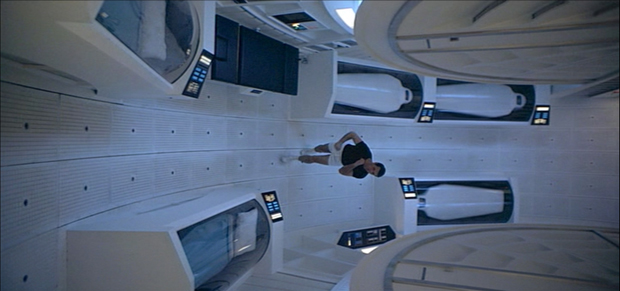
226a turned 180 degrees
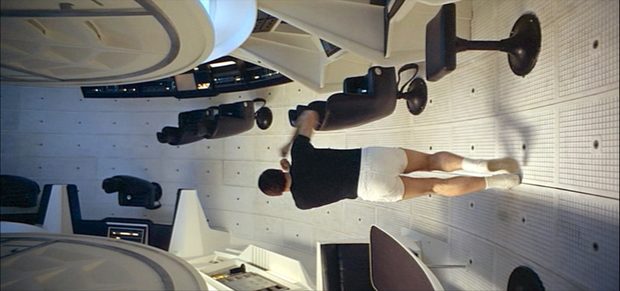
226b
227 Alternative view of Frank running, the camera now following him. (56:48)
In shot 227, the camera follows Frank as he runs in the opposite direction of what he had been. Furthermore, not only is Frank running in the opposite direction, but Kubrick has flipped the orientation of the film horizontally. We don't notice the change because the shots of Frank open with him running in an orientation 90 degrees turned from a normal standing view.
We'll call the below shot 227a. As I said, Kubrick has flipped it horizontally from shot 226.
Kubrick cuts away about here, below. We'll call it shot 227b. There is no break between it and shot 227a. They are one shot.
Below is the scene as it should appear according to the opening shot (226) of Frank Poole's run. It is what happens if we do a horizontal flip of 227a.
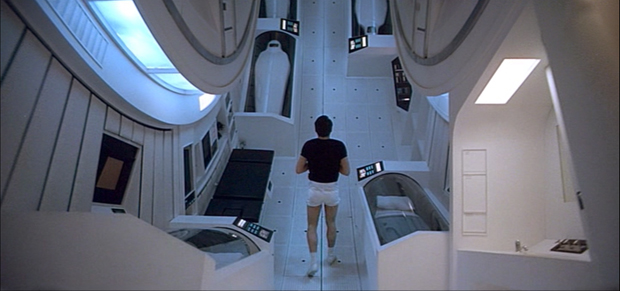
227a flipped horizontally by me, which is the proper orientation according to shot 226 and the remainder of the film
Below on the right is shot 227a which Kubrick has flipped horizontally from 226, compared with the proper orientation in shot 226.
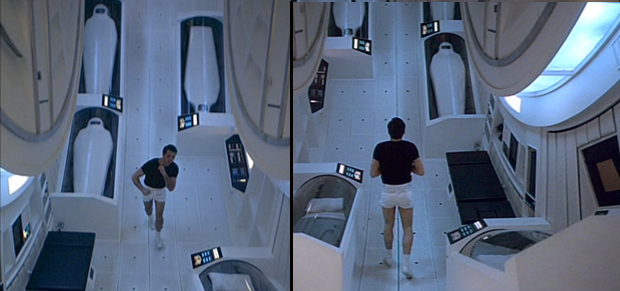
Right: 227a which Kubrick has been flipped horizontally from 226 and is not the propere orientation. Left: Shot 226a, which is the proper orientation, but I've turned it 90 degrees clockwise for comparison's sake.
Below is what it looks like if we do the horizontal flip with 227a. We see how this fits in with what we were shown in shot 226. The orientation of the hibernators is now correct.

Right: 227a which I have flipped horizontally, from Kubrick's, back to its proper orientation. Left: Shot 226a, which is the proper orientation, but I've turned it 90 degrees for comparison s sake.
A wonderfully easy way though of seeing when Kubrick is doing the horizontal flip in these shots is to look at Frank's hair. In 226 it is parted on our left, his right. In shot 227 it is parted on his left, our right. In shot 228 it is parted on his left, our right, and again on his left, our right, in shot 229. In shot 231 it will return to being parted on our right, his left. So for shots 227, 228 and 229, Kubrick has horizontally flipped the scene so we have a reverse image of Frank doing his exercises. However, for the remainder of the film, except for a couple of shots, the proper orientation will be as in the opening shot 226.
Believe me, I really studied this to see what was going on. I did a layout for shot 226 and a layout for shot 227 in order to get it right for the rest of the shots. And then I realized the parting of the hair was such an easy way of telling the difference.
The first image below is how the layout is in shot 226. T stands for table, and H stands for HAL, where they typically dialogue with the computer at the large console.

Below is the layout for shots 227 through 229, which Kubrick has horizontally flipped (reversed).

It was stomach-churning dizzying examining this but it also gave me a chance to really think about how Kubrick did these shots. In shot 226 we are viewing Poole at a 90 degree turn from us and that is already a little disorienting, more so than we probably realize. Because of the way the camera shifts following him, even though we feel like we know what's going on with the layout, we don't. Then Kubrick rights our view of Poole, standing him straight up for shot 227, so we feel like we're getting the real view of things, but we're not, it's reversed, flipped horizontally, though we don't realize it, and Poole is running away from us. Then to even further disorient us, Kubrick comes in closer on Poole in shot 228, which means we're seeing less of what's going on behind him, but as we're viewing him from the front we feel we are getting even better oriented, even though we're wrong as Poole is still in reverse.
In the section on the Orion vessel, in Part Two, I've already written on these clockwise to counter-clockwise shits. In the section on the Aries vessel, again in Part Two, I've already written some on these 90 degree turns. And have commented on them both briefly as well in The Dawn of Man section. In Part One, the first reversal (flip horizontal) shot occurred with the monolith. In Part Two, the first clockwise to counter-clockwise flip happened when Kubrick was showing us the "twin" (nearly symmetrical) pilots. The monolith is itself a representation of perfect symmetry. One could suggest that in shot 227 we have the tanning bed taking place of the monolith's symmetry, but I'm not confident that's so and that Kubrick intends for that to be observed as the necessary coincident for the reversal.
228 Low POV of Frank running, again from the front. (56:04)
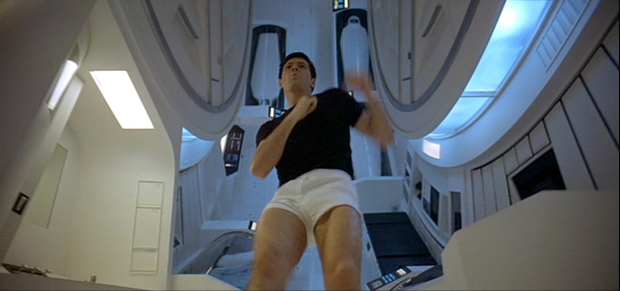
228a. Kubrick still has flipped horizontally the orientation from what it was in shot 26. It's easy to tell as Poole's hair is parted on our right, his left.
He is running in the opposite direction from what we see in shot 227 with the horizontal flip maintained. Kubrick cuts away about here.
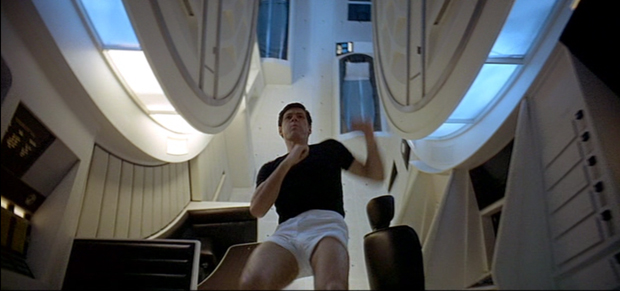
228b. Kubrick still has flipped horizontally the orientation from what it was in shot 26. It's easy to tell as Poole's hair is parted on our right, his left.
229 CU of Frank running in the opposite direction. (57:10)
Kubrick returns with Frank turned and running in the opposite direction from pretty much the exact position where he was cut away from in 228.
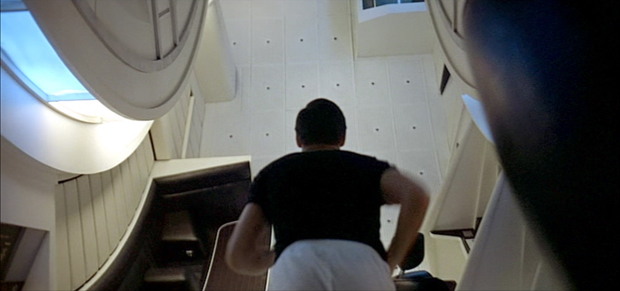
229. Kubrick still has flipped horizontally the orientation from what it was in shot 26. It's easy to tell as Poole's hair is parted on his left when in shot 226 it was parted on his right.
THE ROLE OF THE PHOTOGRAPHER IN AN INTERVIEW WITH HAL, POOLE, AND DAVE, AND A GREAT BIG QUESTION CONCERNING HAL
230 Now we are simultaneously introduced to HAL and Dave Bowman. (57:19)
Bowman moves toward us through a revolving chamber. We see him reflected in HAL's eye.
We are not at all seeing what we think we're seeing, but I don't quite want to get into that yet in the case of HAL.
231 Shot of Frank eating and Dave climbing down into the area to join him. (57:35)
By the time we reach this shot we are pretty discombobulated, if not entirely aware of how twisted and turned we've been, in particular through the use of the reverse orientation. We're not at all sure of what we've just seen as far as orienting the different parts, though we may believe we know where we have been on the map and how it all fits together once we see Dave climbing down the ladder.
232 Long shot of Dave punching in his meal selection, Poole behind him. Poole doesn't look up. (58:17)
233 Medium shot from behind Dave. (58:24)
234 Medium shot from above Poole looking down on him from the right. (58:31)
His tray is arranged so we have orange, green, white, and a brown selection, left to right. Blue cup. His tablet reads that the next scheduled transmission will begin in 3, 2, 1 then 0 seconds. He gets some pre-transmission coding then a series of vertical stripes appear on screen and music begins, the adagio having faded out during shot 232. I have read that the adagio is intended to be a solace to Gayane, who had discovered her husband was treasonous, having embezzled public money with others, and is plotting to set fire to the commune's cotton warehouse with these others and flee the country. When Gayane admonishes her husband he locks her in her room.
BBC 12. The words "The World Tonight" multiply again and again, filling the screen, reminding us of the theme of the eternal return. Finally the announcer appears.
ANNOUNCER: Good evening. Three weeks ago, the American spacecraft, Discovery One, left on its half billion mile voyage to Jupiter.
235 Medium shot Dave from behind, as in shot 233. (58:59)
As we hear the announcer speak, Dave takes hot mini trays of food and places them on the big tray.
ANNOUNCER: This marks the first manned attempt to reach this distant planet. Earlier this afternoon, The World Tonight recorded an interview with the crew of the Discovery at a distance of 80 million miles from Earth.
As Dave goes to sit with Poole we see that Poole's cup changes position from being on his right to being on his left. Also, the arrangement of foods on Dave's tray changes slightly, the two interior trays furthest left being interchanged. Another micro incidental is that the drinkable food on the Aries had been served in white containers (with pics) on blue trays. Here, liquid is again served in blue and white containers, these blue cups having white bands around the mouths.
Shot 232 | Shot 233 |
 |  |
Shot 234 | Shot 235 |
 |  |
236 Shot as in 232, Dave taking his tray and going to the table. (59:11)
ANNOUNCER: It took seven minutes for our words to reach the giant spacecraft, but this time delay has been edited from this recording.
237 Medium shot of two empty chairs before the HAL computer station. We see a number of screens relaying different types of information, one showing the announcer. (59:18)
ANNOUNCER: Our reporter, Martin Amer, speaks to the crew.
AMER: The crew of Discovery One consists of five men and one of the latest generation of the HAL 9000 computers.
238 Shot of HAL with four screens to either side. One reads FLX. A hibernating astronaut is on another. (59:30)
AMER: Three of the five men were put aboard asleep, or to be more precise...
One of the screens changes to read NUC.
AMER: ...in a state of hibernation.
A screen changes to read GDE.
AMER: They were Dr. Charles Hunter, Dr. Jack Kimble, and Dr. Victor Kaminsky.
Shot 238 | Shot 238a |
 |  |
Shot 238c | |
 | |
Most will see this as insignificant, but who is doing the filming of the pods here? We don't think about this because the shots are so like what we see when presented naturally, out of the context of the news story. Aligned diagonally they fit in with other close-up shots of the hibernation pods in the film and so we receive them seamlessly, but we would have done so as well if we were shown shots that looked like a clinical presentation, as in, say, recordings from a camera uniformly placed above each pod. Our perceptions are being played with here. We accept the shots without thinking about the source of them.
239 MCU of Dave eating, his precursor of the iPad to his left. His meal from left to right is a light brown tray of food, a reddish brown tray, an orange-brown-yellow, and a yellow tray. (59:41)
AMER: We spoke with Mission Commander Dr. David Bowman, and his deputy, Dr. Frank Poole.
The pad screen shows briefly Dave, then Frank, then the two seated together before HAL.
AMER: Well, good afternoon, gentlemen. How's everything going?
BOWMAN: Marvelous. Have no... (Looks to Frank who agrees) ...we have no complaints.
AMER (on screen): Well, I'm very glad to hear that and I'm sure that the entire world would join me in wishing you a safe and successful voyage.
BOWMAN (he and Poole onscreen): Thank you, very much.
POOLE: Thank you.
Shot 239 | Shot 239b |
 |  |
Shot 239c | Shot 239d |
 |  |
Shot 239e | |
 | |
Again, we must consider "who" is filming Dave and Frank for the interview. Is it HAL? We are likely intended to assume so, but we have three different angles here with the medium shot and the two close up shots of Dave and Frank in the interview. Later, in shot 335, we will be explicitly shown the area opposite the computer console. Frank and Dave are dialoguing in the interview as if there is not only a camera there but also a video screen nearby it upon which they are seeing a transmission of the interviewer, for they appear to be looking at that screen, at the interviewer, rather than at a camera. If they were talking with the interviewer via only a supposed camera, they would be looking directly at the camera, but they aren't, they are looking to the side of the camera. But when we see the area opposite in shot 335 we will see there is no such screen and I don't view a camera either. Yet Kubrick keeps the interviewer in an "interviewing" space. The interviewer is shown with one fixed studio camera, whereas Dave and Frank are not--there is the medium shot and the close-ups of each. If the audience unquestioningly accepts this then they will unquestioningly gloss over other peculiarities in the film, just as they do with symphonies of oddities in The Shining and Eyes Wide Shut.
The role of the photographer in relation to the film has already been subtly highlighted in section two, and I've written of it there.
240 MCU from above of Poole eating, as in shot 234. (1:00:03)
AMER: Although hibernation has been used on previous space efforts, this is the first time that men have been put into hibernation before departure. Why was this done?
Dave appears briefly on the screen.
Shot 240 | Shot 240a |
 |  |
Shot 240c | |
 | |
241 LS of the three pods holding the hibernating crew. (1:00:15)
This shot is a flip horizontal shot, reversed from the usual orientation, as with shots 228 thru 230.
BOWMAN: Well, this was done in order to achieve the maximum conservation of our life support capabilities.
242 CU of Kimble sleeping and the EMERGENCY REVIVAL PROCEDURE control pad to his side. (1:00:20)
In this shot we return to the original orientation.
BOWMAN: Basically food and air. Now the three hibernating crew members represent the survey team and their efforts won't be utilized until we're approaching Jupiter.
243 CU of KAMINSKY V.F. sleeping. (1:00:28)
244 Medium shot of Poole from above, still eating. (1:00:30)
AMER: Dr. Poole, what's it like while you're in hibernation?
POOLE: Well, it's exactly like being asleep, you have absolutely no sense of time. The only difference is that you don't dream.
245 MS of two of the hibernating crew member's pods. (1:00:40)
This shot is the original orientation.
AMER: As I understand it, you only breathe once a minute. Is this true?
POOLE: Well, that's right.
246 Shot of the life readings: cardio vascular, metabolic levels, central nerv. system, pulmonary function, systems integration, locomotor system. (1:00:45)
POOLE: The heart beats three times a minute. The body temperature's usually down to about three degrees centigrade.
Shot 242 | Shot 243 |
 |  |
Shot 244 | Shot 245 |
 |  |
Shot 246 | |
 | |
247 Medium shot of the computer station as in shot 237, with the two empty chairs before it. (1:00:52)
AMER: The sixth member of the Discovery crew was not concerned about the problems of hibernation, for he was the latest result in machine intelligence...
248 Closer medium shot of the computer station. (1:01:02)
AMER: ...the HAL 9000 computer, which can reproduce, though some experts still prefer to use the word "mimic", most of the activities of the human brain...
The screen showing the interview next to HAL changes to show an image of him and we have yet a fourth camera angle in the interview to add to the other three, this one directly opposite and on HAL's level. This interview image shows to either side of HAL two screens, the top ones are white and the bottom ones are light blue. These aren't colors normally seen on the screens beside HAL.
Much will be made here of HAL as the sixth crew member. If we look back to the Heywood team at Tycho there were six members. Heywood, Bill and Halvorsen were three. I don't know who two of them were, but I suppose it's possible they were the pilots of the moonbus. The sixth member was the photographer, and in a way he was the odd man out as in he wasn't shown on the moonbus...and yet seemed to have been there (as noted before, I cover this in part two). He becomes surprisingly significant in this respect and is the first one we're shown struck by the monolith's signal. The photographer as the observer with his lens in a way has parallels to HAL.
AMER: And with incalculably greater speed and reliability.
The interview screen again shows Amer.
AMER: We next spoke with the HAL 9000 computer, whom we learned one addresses as HAL. Good afternoon HAL. (How is now shown on screen.) How is everything going ?
Shots 247 and 248 are a slightly unusual sequence of shots for Kubrick and how he works as he doesn't often opt for one shot immediately following another with only a slightly tighter frame on the subject. He did the same thing in section two with shots 139 and 140 during Heywood's meeting with the Russians. The difference between shots 139 and 140 is that this slight telescoping removed the heads of two women who don't speak during the meeting. We still see most of their bodies, their hands in their laps, but not their heads.
Shot 139 | Shot 140 |
 |  |
Shot 247 | Shot 248 |
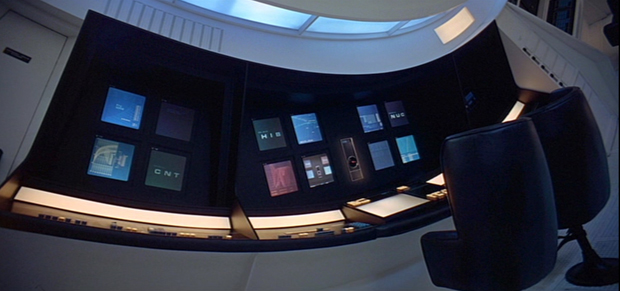 | 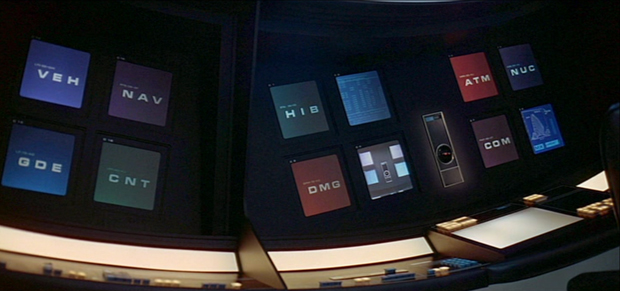 |
Absurd as this may seem, the bright red chairs in these corresponding shots of the Russian conversation, which so grab attention with their design, the way the back rests of them are shaped reminds of the shape of head rests and that in shot 247 the chairs before HAL have no headrests, when they do have them in shot 226 but not in the reverse shot 227. Then again we have the head rests in 231, 232, and 236, as Dave sits down to eat, but the head rests are gone by shot 237 and never appear again in the film. There may be a connection to the later, very important story line of Dave leaving behind his helmet and the frightening procedure of thus having to blast his way into the air lock.
What should be noted here is that in shot 226 we don't see HAL, he is kept out of the frame, obscured, and we have the head-rests. In shot 227 we are shown HAL and don't have head-rests. We return to the original orientation in shot 231, and in shots 231, 232 and 236 we see head-rests, but in these shots we don't see HAL. We have an opportunity to see him in shot 231 but HAL is instead obscured. What has happened is when we don't see HAL we see the head-rests and when we do see him the head-rests are absent. As mentioned above, from now on out we will no longer be shown the head-rests at all.
In The Shining we have a frequent problem of things disappearing. As I state in my analysis of it, I was able to find a consistency to these disappearances. There would be first something like a reverse orientation shot and then we would have a 90 degree shift in some way. If we looked around, we would find something had disappeared. In that film this progression is seen in Danny's ability to escape Jack. In the maze, he reverses his track, walking backward in his own steps, then he jumps to the side at a 90 degree angle and covers his track. Thus he disappears from Jack's view. A very simple thing but we take it as being an ingenious plan, and if we examine the film we see it as part of an established and extremely subtle pattern. If we examine shots 226 and 227 here we have the same. Shot 227 not only shifts us 90 degrees from 226 but we have Frank running in the opposite direction. The head rests are then seen missing from the two chairs before the computer console, and only those two chairs. So Kubrick does the same thing here but also has HAL also being shown in the computer console.
If we examine the case of the missing red helmet, we have the same evidenced when Poole is the pilot on the flight deck and Dave goes EVA, and I will show how this is so when we get to shots 293 and 294.
249 Medium close-up of HAL. (1:01:26)
HAL (on screen): Good afternoon, Mr. Amer. Everything is going extermely well.
AMER (on screen): HAL, you have an enormous responsibility on this mission. In many ways, the greatest responsibility of any single mission element. You are the brain and central nervous system of the ship, and your responsibilities include watching over the men in hibernation. Does this ever cause you any lack of confidence?
250 CU of HAL's red eye. (1:01:47)
HAL: Let me put it this way, Mr. Amer. The 9000 series is the most reliable computer ever made. No 9000 computer has ever made a mistake or distorted information.
Okay, about HAL. The question about HAL. We are shown HAL's big red eye a number of times in this film. Above is the cleanest shot of HAL we will have in the style of CU we have come to associate with HAL. In all sections the shots of HAL are a little different--the cropping or the color temperature, and one other difference I will bring up a little later on. In almost all the shots like this we have several lights reflected on HAL's glass several times. Do you see the same in 249? No. And I have examined this carefully and nowhere on the ship will you see these lights ever reflected in HAL's eye outside these extreme CU shots. As in you will never see them in shots like 249, medium and medium CU shots of HAL. Nowhere. Ever.
This may seem like a little detail of no consequence, but there are numerous reasons why I think it is of consequence, and I'll discuss this at length later. If we examine every shot of HAL we will see eventually how Kubrick makes this a point of significance that demands consideration.
251 Switch now to HAL's perspective of Dave and Poole. (1:02:01)
Does HAL see head-rests on the chairs before him? No, indeed he does not.
HAL: We're all, by any practical definition of the words, fool proof and incapable of error.
252 View from above of Poole and Dave. (1:02:08)
We've already observed how Dave and Poole resemble each other yet don't. However, when the audience is first introduced to the men they appear very much alike and Kubrick intentionally uses this throughout the film. Here, we see how they have become reverse images of each other. Poole is left-handed and his cup was moved to the left side of the tray when Dave joined him. Dave is right-handed and his cup is on the right side of his tray. As Poole is left handed he watches the pad on his right. As Dave is right handed he watches the pad on his left. Kubrick has perfectly, symmetrically placed these viewing pads in order to highlight the reverse imaging and doubling he gives us of these two pilots, as we had observed near perfect twinship with the pilots on the Orion ship, and a lesser but still evident suggestion of doubling with the pilots on the Aires.
And yet...and yet...one will notice that the image on Dave's pad is slightly different than Poole's. They are both watching the same video yet more more white above the console shows on Dave's pad. So, in a way, the men are watching two nearly identical but different videos.
AMER: HAL, despite your enormous intellect, are you ever frustrated by your enormous dependence on people to carry out actions?
HAL (on screen): Not in the slightest bit. I enjoy working with people. I have a stimulating relationship with Dr. Poole and Dr. Bowman. My mission responsibilities range over the entire operation of the ship...
253 Medium shot of the computer console again. (1:02:30)
HAL: So, I am constantly occupied. I am putting myself to the fullest possible use, which is all I think that any conscious entity can ever hope to do.
254 Return to medium shot from above of Dave and Poole, as in 252. (1:02:42)
AMER (on screen): Dr. Poole, what is it like living, for the better part of a year, in such close proximity with HAL?
POOLE (on screen): Well, it's pretty close to what you said about him earlier. He's just like a sixth member of the crew. You very quickly get adjusted to the idea that he talks and you think of him really just as another person.
AMER (on screen): In talking to the computer, one gets the sense that he is capable of emotional responses. For example, when I asked him about his abilities...
255 Medium shot of the computer console as in shot 253. Dave is now on screen. (1:03:09)
AMER: ...I sensed a certain pride in his answer about his accuracy and perfection. Do you believe that HAL has genuine emotions?
BOWMAN: Well, he acts like he has genuine emotions. Uhm, well, of course he's programmed that way to make it easier for us to talk to him. But as to whether or not he has real feelings, it's something I don't think anyone can truthfully answer.
256 The exterior of the ship showing the communications dishes. (1:03:29)
The Gayane music returns.
Shot 253 | Shot 254 |
 |  |
Shot 255 | Shot 256 |
 |  |
HAPPY BIRTHDAY
257 Poole takes a sun bath. (1:03:53)
HAL: Excuse me, Frank.
POOLE: What is it, HAL?
HAL: We've got the transmission from your parents coming in.
POOLE (switching positions): Fine. Would you put it on here, please? And take me in a bit?
HAL: Certainly.
The sun table slides in toward the wall a little as Poole settles back down. His parents appear on the monitor.
POOLE'S FATHER: Hello, Frank!
POOLE'S MOTHER: Happy birthday, darling!
POOLE'S FATHER: Happy birthday. Many happy returns of the day.
POOLE: A bit higher, HAL.
Frank's head rest had been raised but now HAL raises a center part of the head rest a full 90 degrees
POOLE'S MOTHER: Glad to hear you and Dave are well.
POOLE'S FATHER: Yeah, mother and I are both feeling wonderful, too. Ray and Sally were going to be here, too...
258 Close-up of the monitor showing Poole's parents. (1:04:30)
POOLE'S FATHER: ...but at the last minute Ray's back went out on him again.
POOLE'S MOTHER: How do you like your cake, dear?
POOLE'S FATHER: Looks great, doesn't it? Sorry you can't join us. Oh, I ran into Bob the other day. He said to be sure and wish you happy birthday.
POOLE'S MOTHER: Oh, all my students made me promise to send my best wishes, too. You know, they talk about you all the time in the classroom, Frank. You're a big celebrity in...
The numbers 236 are unlit. In The Shining, when Danny has his first encounter with Room 237, which is unlocked, the door across the way, leading to room 236, is open onto darkness. Most people don't notice this because the darkness in the open doorway makes it look like the other closed doors.
259 We are shown Dave asleep in his bed. (1:04:48)
There is but one tanning bed. It is empty. Supposedly the one upon which Poole is currently listening to his parents. It could be that Kubrick is just showing sundry events out of order, but it's curious that he inserts here Dave sleeping next to the empty tanning bed when, in a moment, we will have Poole asleep in his bed while we are shown Dave entertaining himself with sketching at the same time.
POOLE'S MOTHER: ...2nd grade. Oh, we were on television last week.
POOLE's FATHER: Oh, yes, yes.
Is that a picture of a landscape on the monitor above Dave's bed? Appears to be. It is the one "earth" picture we will have of a landscape,not counting the Monument Valley images shown in the Star Gate section or the paintings in the Infinity Hotel. It would seem that Dave likes to be reminded of home earth when he goes to sleep.
260 A CU of Dave sleeping. (1:04:52)
The monitor above Dave's bed in 259, it is now absent.
POOLE'S FATHER: Your mother and I and Dave's parents were interviewed about what we thought of our illustrious sons. You can imagine...
261 Return to Poole watching the monitor as with shot 257. (1:04:57)
POOLE'S FATHER: ...what we told them. I think it's being broadcast next Thursday. Perhaps you'll be able to listen in.
POOLE'S MOTHER: Oh, we were thrilled about Elaine and Bill, dear. I'll be glad to get the present for you but please tell me how much I can spend.
POOLE'S FATHER: Oh, Frank, yes, about your AGS 19...
262 CU of Poole with the orange visor over his eyes, reminding of HAL. (1:05:10)
In this shot, the center portion of Poole's head-rest is not raised to the fully vertical position.
POOLE'S FATHER: ...payments, I think I've straightened it out for you. I talked to the accounting office in Houston yesterday and they said that you should be receiving your higher rates of pay by next month. Well, Frank...
263 Return to Poole watching the monitor as with shot 261. (2:09)
POOLE'S FATHER: ...I can't think of anything else to say, now.
POOLE'S MOTHER: Oh, give our love to Dave.
POOLE'S FATHER: Oh, yes, be sure and give him our best regards. We wish you the very happiest of birthdays.
POOLE'S MOTHER: All the best.
POOLE'S FATHER: All the best, son.
POOLE'S PARENTS SINGING IN UNISON: Happy birthday to you, happy birthday to you, happy birthday, dear Frank, happy birthday to you.
POOLE's FATHER: See you next Wednesday.
The transmission ends and flickers out.
HAL: Happy birthday, Frank.
POOLE: Thank you, HAL. A bit flatter please.
HAL lowers Poole's head rest a little.
Shot 261 | Shot 262 |
 |  |
Shot 263 | |
 | |
Kubrick sometimes uses a pattern that will have a reversal and a diagonal movement accompanied by something disappearing. With Frank's suntanning, he reversed his position, then had HAL lift his head rest, which was only about 45 degrees rather than 90, but then we see in shot 259 Frank no longer in the suntanning bed while Bowman is in his bed.
CHESS WITH POOLE (ALTERNATE MOVES AND SIMULTANEOUS VIEWS)
264 Poole plays chess with HAL. (1:05:02)
POOLE: Anyway, queen takes pawn.
The far upper left square illumines, the queen moving forward two rows and taking the pawn.
HAL: Bishop takes knight's pawn.
HAL'S bishop moves from H3 to 2G, taking a pawn.
POOLE: Oh, lovely move. Rook to King 1.
The rook moves from F1 to E1.
HAL: I'm sorry, Frank, I think you missed it. Queen to Bishop 3.
The queen moves from D3 to F3.
|
|
Left: HAL moves his black queen from D3 to F3. Right: What the chess board would look like
from the perspective of the one playing black with the move of the queen from D3 to F3.
HAL: Bishop takes queen. Knight takes Bishop. Mate.
POOLE: Oh, yeah, looks like you're right. I resign.
HAL: Thank you for a very enjoyable game.
POOLE: Yeah, thank you.
I don't know anything about chess but the big deal here is supposed to be HAL in some way misinforming Frank on the chess game, such as HAL says "Queen to Bishop 3" when he should have said Queen to Bishop 6. His saying Queen to Bishop 3 seems to be what one should say if they're playing the white pieces, which would be Frank, and HAL is playing the black.
HAL does not highlight the prospective moves. He merely says, bishop takes queen and knight takes bishop. Mate. That is what this would look like below.
Without HAL going belly-up stupid, I don't know if Frank could have staved him off to the point of winning. It seems there are a number of pellmell moves Frank could make rather than absolutely definitively having to capture the queen with his bishop and HAL then taking that bishop with the knight. But strategically they wouldn't make any difference except to stave off the inevitable. I've read that in this game the white queen could have instead moved to E6 or H6 which I don't get as that just looks like an immediate sacrifice. Never mind. Frank didn't absolutely have to make the move that HAL foretold, his bishop taking HAL's queen, but he accepted HAL's reasoning. He didn't protest. He gave up the battle at HAL's suggestion. "This is what you would have done and you would have lost," HAL essentially tells Frank, and Frank says, "OK. I guess you're right. It's done and over." We have that then to consider, that Frank didn't tell HAL, "No, I'm not going to do it that way, the way you're telling me." And we have to consider that HAL rather forced this end on Frank. At the very least, he suggested it, to his advantage, and Frank didn't protest.
One could wonder if HAL was intentionally challenging, and then practicing deception.
|
|
Left: HAL says "Bishop takes Queen" showing his anticipation of Frank taking his queen.
Right: HAL says "Knight takes bishop" showing how he would take Frank's bishop and put Frank's king in mate, ultimately checkmate.
There is another entirely different way of looking at HAL's prognostication of the bishop taking the queen and the knight taking the bishop. It's going to look nuts, but here it is.
|
|
Right: HAL says "Bishop takes Queen" but he has not designated which bishop, so let's move his bishop to take the queen.
Left: HAL says "Knight takes bishop" showing how he would take his own bishop.
There is no mate. But let's bypass that for a moment. There is even a third way of perceiving HAL's prognostication as we don't have the algebraic notation for the moves and HAL doesn't highlight them.
|
|
Right: HAL says "Bishop takes Queen" and Frank's queen takes HAL's bishop.
Left: HAL says "Knight takes bishop" showing how his knight would take his own bishop.
Because algebraic notation isn't used, I am for now going to present this as 3 alternatives based only on the language used, how HAL doesn't use algebraic notation. In my analysis of The Shining I discuss how Kubrick often presents 3 views for a scene, the most notable being the famous bathroom in room 237 where we have Jack's view, Dick's view and Danny's view, and we've no idea really who exactly is seeing what. One reason I do this also is because HAL has already given the move of the Queen as to bishop 3, Frank's perspective, when it should have been bishop 6, HAL's perspective. This plays in with the inversions, the horizontal flips I've talked about, which is exactly what it is with bishop 6 becoming instead bishop 3. Only one game, of course, results in a checkmate but all of them involve the 90 degree diagonal jump of a knight. As I've said,
In Lolita, Kubrick made a point of the diagonal movement of the knight, Humbert discussing it immediately before he takes Charlotte's queen. She lifts up a knight and remarks that this can go back and forth, and Humbert replies yes, it can go around other pieces. Charlotte says, "It goes around corners." (That diagonal movement highlighted.) Then as Lo enters she observes, "You're going to take my queen" and Humbert says that's his intention. Charlotte sends Lo to bed, she makes an absurd move with her queen, Humbert remarks that wasn't very clever and takes her queen with a knight. As I've stated, Kubrick sometimes uses a pattern that will have a reversal and a diagonal movement accompanied by something disappearing, much like it being pointed out that Charlotte's knight can go back and forth and around other pieces.
As Kubrick makes so much of these knight moves, I would wonder if a reason this particular chess game was chosen because it ended with the coup with the two knights poised as they are.
Kubrick based this 2001 game on a Roesch vs. Willi Schlage game played in 1910. I read that Schlage seems to come from the German "schlagen" which means "to beat" and is taken also to mean "to capture".
Something of note to add about the etymology of bishop, from the Online Etymology Dictionary:
Old English bisceop "bishop, high priest (Jewish or pagan)," from Late Latin episcopus, from Greek episkopos "watcher, overseer," a title for various government officials, later taken over in a Church sense, from epi- "over" (see epi-) + skopos "one that watches, one that looks after; a guardian, protector" (see scope (n.1))...Late Latin episcopus in Spanish became obispo. Cognate with Old Saxon biscop, Old High German biscof. The chess piece (formerly archer, before that alfin) was so called from 1560s.
Scope is a target, a mark, something aimed at, even to spy. You can see in the idea of the "bishop" thus several things. The chess piece was once the archer, which reminds of Bowman. Then we have the watcher, a guardian, someone who looks over, which reminds of the Overlook and Jack's position as a kind of guardian for the hotel.
It may seem very peculiar, this idea of having three different viewing points/possibilities for the game, and that I am tossing paying any attention to who is playing black and who is playing white, but we already have HAL leading the way with this. For, after all, with doublings and twinnings, and the ideas of these horizontal flip mirrorings, we have dualism and everyone is familiar with black and white's symbolism in dualism, such as expressed in the Yin Yang symbol. I will be talking more about these blacks and whites in a moment.
SKETCHING WITH DAVE, AN ORACLE FROM HAL (WHOSE EYE IS NOT WHAT IT SEEMS TO BE) AND MORE CHESS
265 CU of Dave sketching the three hibernators. (1:06:53)
266 LS of Dave sketching the hibernators, Poole asleep in his pod. (1:06:55)
The orientation is correct as in 226. Poole's bed is the one opposite in which Dave had been sleeping in 258.
267 LS, even further out, of Dave sketching the hibernators and Poole sleeping. 1:07:03
This perspective is almost exactly the same as the beginning of shot 227 only with the proper orientation, not flipped as it was there.
Dave turns and walks back toward the computer console. In this shot, the chairs before it don't have head-rests.
HAL: Good evening, Dave.
BOWMAN: How're ya doing, HAL?
HAL: Everything's running smoothly. And you?
BOWMAN: Oh, not too bad.
Shot 265 | Shot 266 |
 |  |
Shot 267 | |
 | |
268 CU of HAL's eye. (1:07:33)
HAL: Have you been doing some more work?
BOWMAN: A few sketches.
HAL: May I see them?
269 Dave is seen through HAL's perspective. There are no head rests on the chairs, again. (1:07:37)
DAVE (sits and shows the first): Sure.

HAL: That's a very nice rendering, Dave.
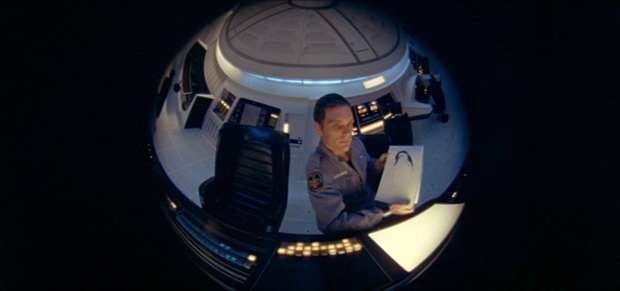
HAL: I think you've improved a great deal.
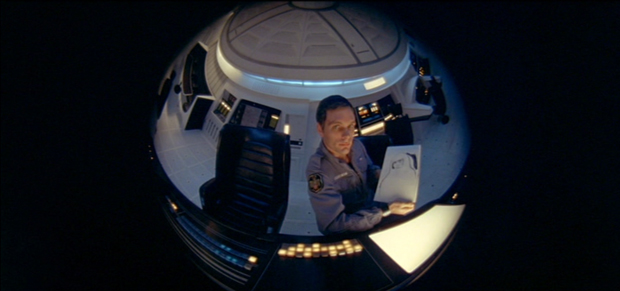
HAL: Can you hold it a bit closer?
DAVE (holding it closer): Sure.
HAL: That's Dr. Hunter, isn't it?
BOWMAN: Uh-hum. (He flips to the next one.)
HAL: By the way...

HAL: ...do you mind if I ask you a personal question?
BOWMAN: No, not at all.
HAL: Well, forgive me for being so inquisitive...
When Dave holds up the sketches so that HAL may examine them more closely, we notice that they cover the chair in which Poole is frequently seated.
Kubrick has HAL taking after Symslov (named after a chess master) who had said, "Dr. Floyd, I hope you don't think I'm being too inquisitive, but perhaps you can clear up the great big mystery about what has been going on up there?"
270 Medium 3/4 shot of Dave and HAL from behind Dave. (1:08:11)
The chairs have no head rests.
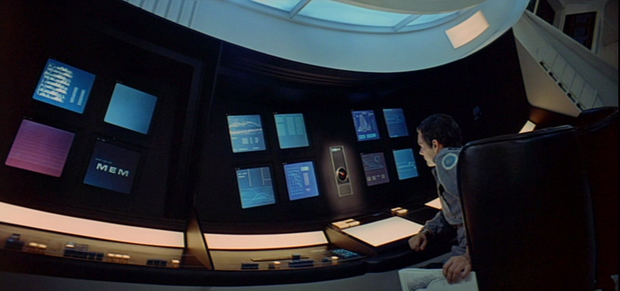
HAL: ...but during the past few weeks, I've wondered whether you might be having some second...
271 CU of Dave. 1:08:16
No headrest. (Gets tiresome my noting that.)
HAL: ...thoughts about the mission.
BOWMAN: How do you mean?
Again, we have to some degree a repeat of the Smyslov/Floyd conversation, as Floyd had replied to Smyslov, "I'm afraid I don't know what you mean."
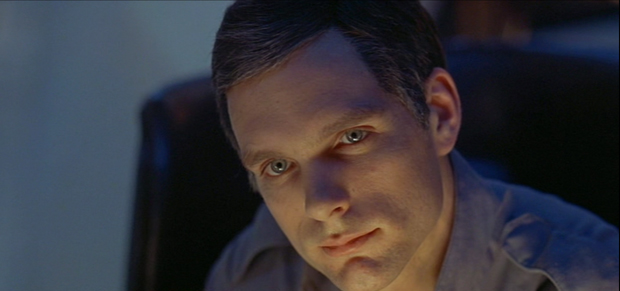
272 CU of HAL's eye. (1:08:20)
HAL: Well, it's rather difficult to define. Perhaps I'm just projecting my own concern about it. I know I've never completely...
Compare this shot of HAL to 268 and 250. In 250 and 268 the lights reflected are fully shown. Here the center light is occluded by something. We also had that occlusion in shot 230 in which we had HAL reflecting Dave revolving.
In the middle of this very decisive conversation, HAL's eye changes.
This occlusion was explicitly shown by Kubrick not to have appeared directly after the chess game with Poole, however. Instead it follows HAL asking Dave if he's had second thoughts about the mission--but, as I noted, we viewed the occlusion also in shot 230.
HAL knows the secret of the mission, of which none of the five human members of the crew are aware. After viewing the sketches, HAL prompts Dave to divulge his own suspicions if he has any. HAL has no suspicions, so there's no use psychologizing that HAL is projecting anxieties on Dave. HAL knows. There's a connection to be had between this conversation and the one between Smyslov and Heywood. Smyslov, suspecting something amiss, pried Heywood for facts that Heywood would not divulge, Heywood only saying he wasn't at liberty to talk about it. HAL is also attempting to get Dave to reveal his thoughts, which Dave doesn't divulge.
HAL, by nature of his mission, must be duplicitous. Dave, counter HAL, is much like him. He is decidedly inexpressive. Kubrick has Dave acting in a very flat manner. He scarcely moves in the shots in this scene. His eyes stare fixedly back at HAL. What we do know is he avoids discussing with HAL anything concerning his emotions, his suspicions, his anxieties, his uncertainties. He simply observes for HAL that he believes he's working up a psychology report, showing that he knows HAL is attempting to discern his psychological state. He obscures. There is a kind of occlusion at work.
The first shot had of HAL showed this occlusion was in conjunction with a reflection of Dave, and now appears again during this conversation with Dave. It seems something about Dave would be a factor.
We first saw Dave in shot 224 on the flight deck and for some reason we didn't have color in the flight deck in that shot, and now we have Dave showing HAL his black and white sketches. As with the individuals in these sketches, Kubrick had embedded Dave in a black and white world on the flight deck when we first saw him, desaturating Dave of any color.
273 Dave as seen from HAL's perspective. (1:08:32)
No rests.

HAL: ...freed myself of the suspicion that there are some extremely odd things about this mission. I'm sure you'll agree...

274 Return to angle as shot 270 of Dave viewed 3/4 from behind. (1:08:41)
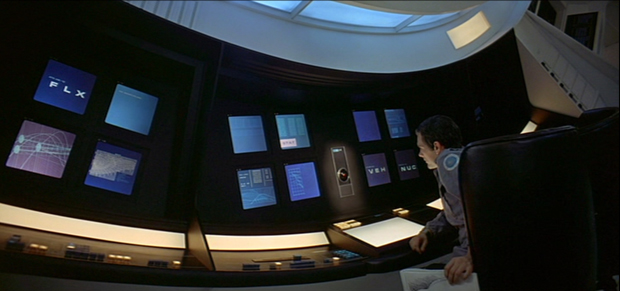
HAL: ...there's some truth in what I say.
DAVE (moving now and placing the sketch book in his lap as he settles back): Well, I don't know. That's a rather difficult question to answer.
275 CU HAL's red eye. (1:08:48)
Again there is the occlusion in HAL's eye.
HAL: You don't mind talking about it, do you, Dave?
276 Return to HAL's perspective. (1:08:51)

BOWMAN: No, not at all.
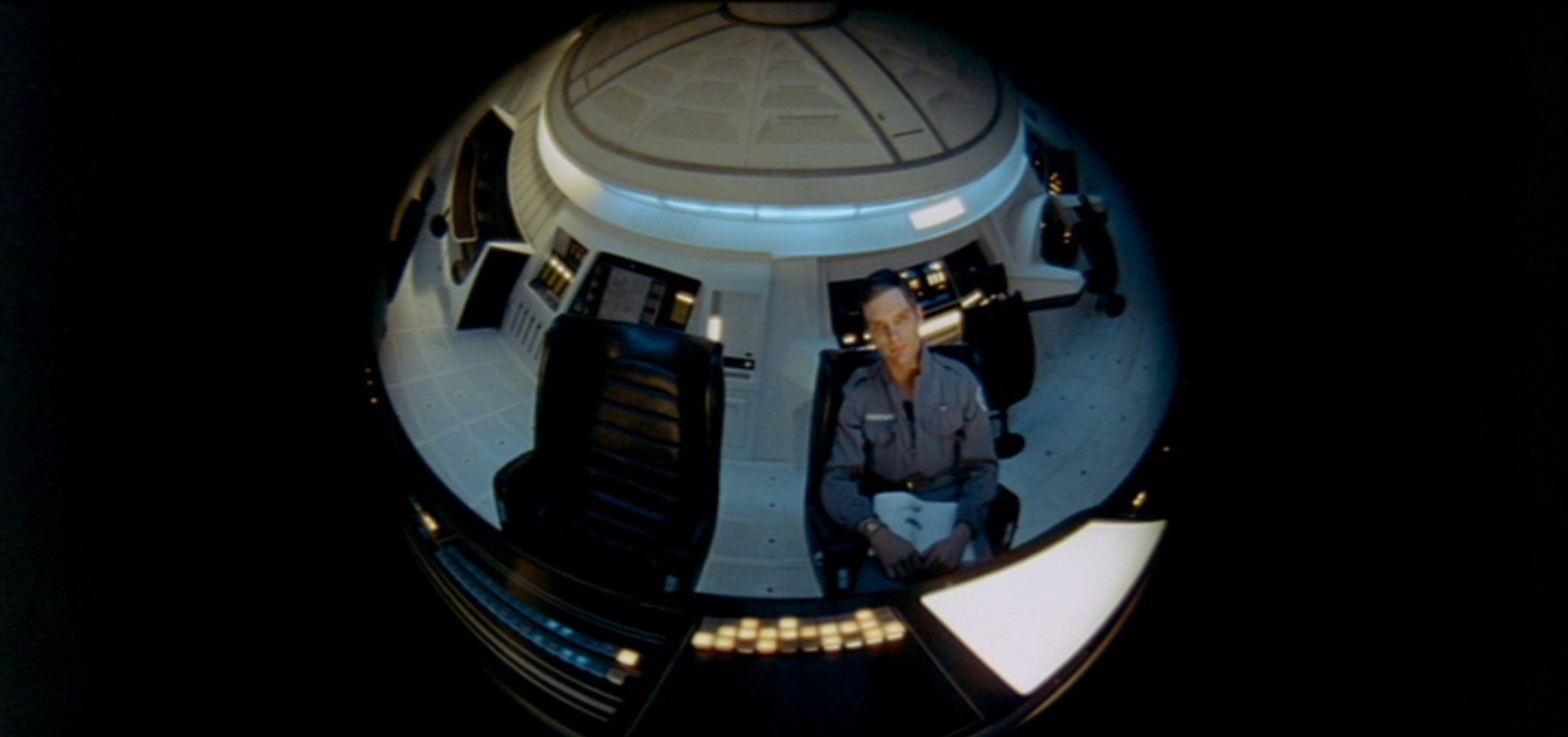
HAL: Well, certainly no one could have been unaware of the very strange...
In shot 270 Dave is leaning forward, holding his sketchbook to the side. After shot 273, in which we view Dave seated back, holding his sketchbook in his lap, with shot 274 we drop back to the view of 270 in which Dave is leaning forward, and at the end of that shot have Dave settling back and putting his sketchbook in his lap in a way that should precede shot 273. In shot 276 we return to Dave's positioning as in shot 273. This will come up for consideration again later.
277 Dave and HAL from behind Dave. 1:08:58)
HAL: ...stories floating around before we left.
MEM is on one of the screens.
HAL: Rumors about something being...
278 Return to CU of Dave. (1:09:04)
HAL: ..dug up on the moon. I never gave these stories much credence, but particularly in view of some of the other things that have happened, I find them difficult to put out of my mind.
279 Dave from the side, looking hard at HAL. (1:09:17)
HAL: For instance, the way all our preparations were kept under such tight security. And the melodramatic touch of putting doctors Hunter...
280 Return to CU of Dave. (1:09:27)
HAL: ...Kimbal and Kaminsky aboard, already in hibernation and after four months of separate training on their own.
BOWMAN: You're working up your crew psychology report.
HAL has put some effort into prompting Dave to divulge any anxieties. Dave doesn't know what happened on the moon. HAL pretty much lays out a path of curiosity for Dave, if Dave wasn't already curious. He brings up something having been dug up on the moon, or at least rumors of this. He connects what may have happened on the moon with the peculiarities of the tight security around their mission, and individuals put into hibernation, those individuals having had separate training, which would bring to mind the suspicion that perhaps they were put in hibernation so they wouldn't share information they had, for what their training had been. This way no one can compare notes and piece together the truth about the mission. The other crew members having been put into hibernation has nothing to do with conserving resources, it is about keeping all from figuring out what is going on.
HAL even aggressively asserts to Dave that there is something really odd about the mission. "Dave, there's something really odd about this mission you're on. Haven't you noticed, Dave?" Dave says he's open to talking about it but then, rather than exposing his thoughts, he flatly, emotionlessly shuts HAL down asking him if he's preparing his psychology report. In other words, "HAL, this is not a real back-and-forth conversation. You are trying to dig around in my mind and disguise it as a real back-and-forth, intimate conversation."
281 HAL's red eye. (1:09:39)
HAL's eye still has the occlusion. With Bowman's response that HAL must be working up his psychology report, rather than further pursuing the matter, HAL states there is a fault in the AE35 unit.
HAL had perhaps intentionally challenged and tested Frank, who gave up. Now HAL has challenged Dave, and Dave, like Heywood, goes cold and gives no ground.
HAL: Of course I am. Sorry about this. I know it's a bit silly. Just a moment...just a moment...
282 Return to CU of Dave. (1:09:50)
HAL: I've just picked up a fault in the AE35 unit.
283 CU of Hal, but not only on his eye. (1:09:56)
HAL: It's going to go hundred percent failure within 72 hours.
HAL displays a graphic of the communications dishes.
Not insignificantly (I don't believe) as HAL relays this information, in the upper right screen next his "eye" we see at the bottom the word "environmental". This fades out of view just as the graphic of the antennae revolves around toward us.
As the antennae revolves toward us, in the graphic, one could say the front resembles one of the targets (the landing pads) we were earlier shown. HAL revolves the unit and also turns it at a 90 degree angle, that Kubrick pattern. As the dish finishes revolving toward us the target aspect disappears.
I say "dish" but I have come to think of AE35 as a crater. What is a crater but a cup. None of the space stations in the second section have this version of an antennae, I believe. But now on Discovery One we have this large dish, this crater, just as we had the crater water hole in section one, then the Tycho crater in section two, and finally this crater which is depicted here in blue and white. The cups out of which Dave and Frank drank were also blue and white.
284 CU of Dave. (1:10:04)
BOWMAN: Is it still within operational limits right now.
HAL: Yes.
285 CU of HAL's eye. (1:10:06)
HAL: And it will stay that way until it fails.
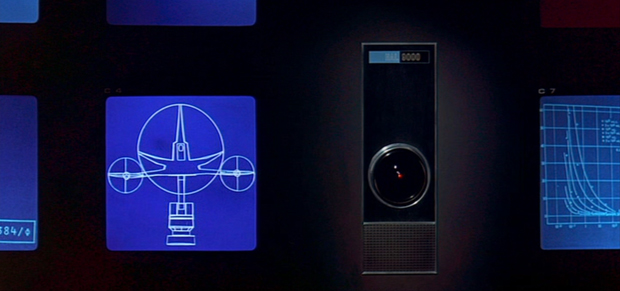
286 CU of Dave. (1:10:09)
BOWMAN: Would you say we have a reliable 72 hours until failure.
HAL: Yes. That's a completely reliable figure.
BOWMAN: Well, then I suppose we'll have to bring it in, but first I'd like to go over this with...
287 Medium shot of Dave from behind. (1:10:19)
BOWMAN: ...Frank and get on to Mission Control. Let me have the hard copy on it please.
HAL ejects a card which Dave takes.
Shot 277 | Shot 278 |
 |  |
Shot 279 | Shot 280 |
 |  |
Shot 281 | Shot 282 |
 |  |
Shot 283 | Shot 284 |
 |  |
Shot 285 | Shot 286 |
 |  |
Shot 287 | |
 | |
The Alpha Echo 35--what about its name? To echo fits in with the doubling but something else occurred to me as I was looking at chess plays. What are called the ECO codes (Encyclopaedia of Chess Openings) is a classification system for chess opening moves. ECO A35 is
an opening move which is also called the English symmetrical. The algebraic notation for ECO A35, the moves enacted in it, are 1.) c4 c5, then 2.) Nc3 Nc6. So you have a white pawn moving to c4 with a reciprocal move of a black pawn moving to c5, then you have a white knight moving to c3 with a reciprocal move of a black knight moving to c6.
You'll recall that HAL had moved a queen to bishop 3 (f3) and that a problem with this was he stated the move as if he was playing white rather than black. As he was playing black, his reading of the board should have been instead f6.
If we look back at the shots of the Tycho Magnetic Anomaly, we'll see in the first shot a suggestion of a chess board which has 8x8 squares. A full 64 squares aren't literally shown, instead we have 8X8 suggested, but I feel it's legitimate to look at it in respect of a chess board as we will later have occasion to see a chess board suggested in a room elsewhere in the film.
If you look at the second shot you'll see the anomaly located at 45 degrees south.
Alpha Echo 35 could perhaps refere to ECO A35, or Echo Alpha (the a) 35, the name for the English symmetrical variation of a chess opening in which we have moves to squares numbered 4 and 5 and then 3 and 6. The 45 reminds me of the 45 degrees south of the TMA. And if we go back to HAL's game with Poole we find the cut off point (White, or Poole, gives it up) with HAL's move of the queen to bishop 3, which he should have stated was bishop 6. It seems we may have n opening chess move reflected in the shots of TMA and the second part of that move suggested also in HAL's game with Frank.
You could say, "But what of the 34 (N) prominently displayed in the first shot of TMA 1."
|
|
In the image above, on the left is ECO A34. On the right is ECO A35 in which symmetry has been enacted. We don't have an exact horizontal flip or mirror image with ECO A34 as we do with ECO A35.
It's something to at least consider. In this opening move, both knights are deployed, and the Roesch and Schlage game had ended with both knights worrying the king. The Roesch vs. Will Schlage chess game had also opened with both knights moved out first but it wasn't a symmetrical opening, instead after the pawns were moved to E4 and E5, the white knight moved to F3 and the black knight responded by leaping to C6.
288 Shot of Poole from above while we see Dave's feet in the background, he standing at a 90 degree angle from him. (1:10:27)
Poole looks above at us, directly at the camera. The camera zooms out so we may better see the scene.
Kubrick has presented Poole to us in a diagonal (corner turn) relative to Dave.
Poole shifts and sits now in the right seat, buckling his seat belt.
289 The revolving chamber in which we first saw Dave Bowman after the exercise scene, only now we're at the opposite end and able very briefly to view HAL's eye at the end (which I don't show in the shot below). (1:11:00)
We realize the chamber isn't revolving, as it had seemed in shot 232, instead the area that is turning is only that in which is HAL. Dave and Poole enter and walk toward HAL.
The two astronauts/pilots become more and more similar in these scenes so that it is difficult to tell them apart unless we get a really good look at them. They step into the turning area and thus now they are also revolving. A door opens. Poole enters and climbs through as it is turned 180 degrees (upside down) from us. Dave enters as the turning wheel is more oriented to our position.
290 View from behind of Dave and Poole seated before the computer console. Dave sits screen left and Poole to the right. (1:11:44)
Mission Control comes on the screen.
MISSION CONTROL: X-RAY Delta One, this is Mission Control. Roger, you're two zero one three. Sorry you fellas are having a bit of trouble. We are reviewing telemetric information in our mission simulator and uh will advise. Roger your plan to go EVA and replace Alph Echo three five unit prior to failure.
DAVE'S SPACE WALK
291 Astronaut in red atmospheric suit from behind, progressing away from us in an octagonally shaped chamber. (1:12:07)
This shot of the astronaut in the octagon chamber is very similar to shot 289 only we now have one individual in a black an white chamber.
What happens if we compare these two shots with shot 230?
Looking at these shots together, We see an infinity effect with a number of ellipses in shot 289 (bottom) which become lights in the hexagon in shot 291. This infinity, vanishing point effect will also be seen later with HAL's eye. It isn't yet pronounced at this point but we see in shot 230 (the middle) how this infinity effect has been impressed upon HAL in reflection.
If we think in terms of degrees, in shot 289 we have Dave and Poole in a 360 degree chamber. In shot 291 we now see only one astronaut and the internal degrees of the chamber have doubled to 720. Poole may not be present but the twinship aspect is.
Most directors would immediately show us who is in the suit, but Kubrick doesn't, keeping us disequilibreated.
We have also now the heavy sound of the astronaut breathing entering for the first time, something which will accompany us now through much of the rest of the film.
The astronaut steps into the EVA pod bay and we see on the right a suspended blue suit.
292 Medium-long shot, low, from between two of the pods,showing the front of the astronaut with the blue suit behind him. (1:12:28)
We also see a yellow helmet hanging next to the blue, no suit below it.
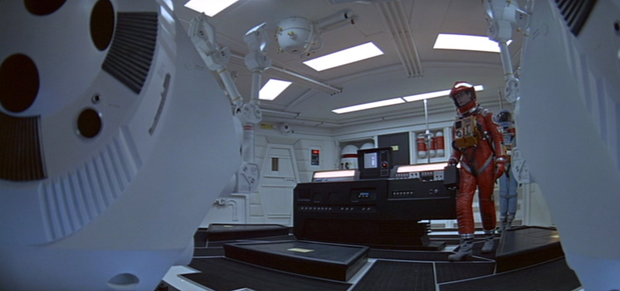
BOWMAN: Prepare B pod for EVA, HAL.
The scene is flooded now with light from the B pod which then revolves toward us as it turns 180 degrees about.
Only now, with Dave's voice, are we confident he is the astronaut in the suit.
293 Medium-long 3/4 side shot of Dave as the pod continues rotating. (1:12:52)
BOWMAN: Open the pod doors, HAL.
The pod door opens and Dave begins to climb in.
294 View of Dave on the CM4 screen on the computer console. (1:13:07)
That would be Poole seated to the left, his shoulder, but we don't know yet that this is a view of the computer console on the flight deck.
We have an intentional split second fall back in time here. In 294 we catch Dave a split second before he lifts his leg to enter the pod, and his positioning is in reverse to what we see in 293. For his body positioning to be as it was in 293, we would need to do a horizontal flip.
In fact, if we apply this flip...
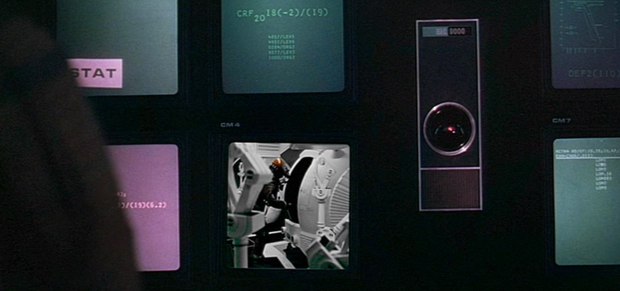
Yes, that's right, what we're seeing on CM4 is the same as 293, only cropped in. His air hose, which has been on his right, also now is on his left if one looks closely.
One may look at HAL's eye on the computer console behind Dave and wonder why we're not seeing Dave from that perspective. Which is the perspective we should be seeing him, right? From HAL's POV? But, as we've observed, elsewhere, HAL's world is a spherical world. This shot is not. So it would seem perhaps there is a camera to the side that HAL is operating through which we are viewing this. Just as in the interviews of Poole and Dave with the BBC reporter we saw the men from three different perspectives via a camera facing HAL and the men before the computer console.
At any rate, it's again interesting that we have this horizontal flip and this backing up in time.
Earlier on this page I'd noted the following:
Absurd as this may seem, the bright red chairs in these corresponding shots of the Russian conversation, which so grab attention with their design, the way the back rests of them are shaped reminds of the shape of head rests and that in shot 247 the chairs before HAL have no headrests, when they do have them in shot 226 but not in the reverse shot 227. Then again we have the head rests in 231, 232, and 236, as Dave sits down to eat, but the head rests are gone by shot 237 and never appear again in the film.
I had wondered if there might be a connection to Dave later leaving behind his helmet in the pod bay and the frightening procedure of thus having to blast his way into the air lock.
Dave in the pod bay, when we see the yellow helmet by itself, we wonder where the suit is as we we've not yet seen Poole wearing it in the flight control deck.
In The Shining we have a frequent problem of things disappearing. As I state in my analysis of it, we end up having a pattern that is like Danny's escape at the end, his reversing and walking backward in his own steps, then he jumps to the side at a 90 degree angle and covers his track. Thus he disappears from Jack's view.
If we examine shots 226 and 227 we have the same. Shot 227 not only shifts us 90 degrees from 226 but we have Frank running in the opposite direction. The head rests are then seen missing from the two chairs before the computer console, and only those two chairs. So Kubrick does the same thing here.
What happens if we examine shots 293 and 294 in light of what I've said above. In 294 we find a horizontal flip, a reverse image, plus a backing up in time that accompanies Dave lifting his leg at a 90 degree angle. Then the next shot shows Poole on the flight deck without his yellow helmet. Kubrick will return to his idea when in shot 350 he shows Poole, from behind, first stepping into the pod, his leg bent at the 90 degree angle, and the red and yellow helmets looking on. So we may have the pattern of the reverse move/horizontal flip with the diagonal. I only examine it for this because of the horizontal flip happening.
We've another couple of shots before this where we had the fall back in time.
In shot 220 the photographer reacts to the piercing sound of the monolith. Then in shot 221 he is shown not reacting yet. His reaction soon follows.
In fact, we have another fall back in time in the Aries.
Alignment of the target area had been moving clockwise, then changed to counter-clockwise in shot 167 and was accompanied by a brief fall back in time.
Why have I included here the image of the Aries then descending? The half red circle. In shot 220 we have the red half circle appearing next the photographer as the sound of the monolith strikes him and then we have a fall back in time. In shot 169 of the Aries descending, after the time shift, we have the ship briefly split into a half white orb and a half red orb.
Do we have also a half red orb evident when Dave is climbing into the pod and we have the fall back in time? Yes, we do. Dave's suit in that shot appears to be black (I said appears to be black, it doesn't have to be black) while his red helmet is the half red orb in shot 294.Yes, Dave's helmet is not shaped like an orb but in shot 294, as viewed apparently by Poole by some unknown camera, the front part of the helmet is dark and thusly we have the red half orb. And, actually, if we examine the shot closely, though a bit of green is observed in the foreground shadows, the shot itself appears desaturated of color with the exception of the half red orb of the helmet. For instance, not only do we not observe red elsewhere, the ochre color of the rings on the "arms" of the pods in the foreground is desaturated to a dark gray.
This may remind of Dave on the flight deck being in black and white when we first view him in shot 224.
295 Medium shot of Poole seated in a cock pit, dressed in the yellow suit. (1:13:13)
296 Extreme distant shot of the Discovery One. (1:13:17)
An asteroid appears out of nowhere, comes rushing at us and over, then a second.
Shot 295 | Shot 296 |
 |  |
297 CU of Dave's face through his helmet's screen. (1:13:31)
He looks directly at us.
298 MS of the B pod from the side. (1:13:35)
The pod bay door opens and the pod is slid outside on a platform.
299 LS of the pod exiting the Discovery One on the platform. (1:14:03)
Shot 298 | Shot 299 |
 |  |
300 Longer shot of the pod exiting the Discovery One. (1:14:13)
This appears to be shot 224 though with the flight deck in color, and now we have the pod being ejected. In fact, it is the same shot as 224. The lights and shadows are the same. The communication dish is at the same angle. The person on the pilot deck appears to make no movement throughout here, and it is obviously Poole in shot 303 whereas it would have been Dave in shot 224 in black and white.
If one looks closely one will realize that we can see Dave's red helmet hanging behind the computer console in shot 300, not Poole's yellow helmet. We see that it is red. Also, if it was Poole's helmet it would be hanging next to the blue atmospheric suit.
The inconsistencies here with what we know to be going on in the primary story line should be of interest because of Kubrick using this shot when we first saw Dave and the flight deck was in black and white. That we see Dave's red helmet plays in with the ambiguities in the next section when Poole goes EVA instead. This is purposeful and further confuses the two incidents which are closely connected, Poole's EVA being a replay of Dave's. It may seem peculiar that Kubrick would purposefully confuse the two walks, meshing them together in this fashion, but one will see in the next section how he also strongly reinforces the sense of doubling, of twinship, having shots from Poole's exercise being nearly indistinguishible from Dave's.
301 Return to CU of Dave as in shot 297. (1:14:23)
302 Dave from directly above in the pod. (1:14:25)
303 3/4 view of the Discovery One and the pod lifting off. (1:14:33)
Again we see Poole on the flight deck.
The pod rises to the level of the flight deck, rotating to face it. The lights pass over Poole and he moves. Fantastic shot.
304 3/4 rear view of the Discovery One with the pod rising above its head. (1:14:54)
Shot 301 | Shot 302 |
 |  |
Shot 303 | Shot 304 |
 |  |
305 Side view of Poole on the flight deck. (1:15:04)
306 3/4 view from behind Dave in the pod. (1:15:09)
The pod is now to the side of the ship.
307 View from above the communication dishes. (1:15:22)
They are slowly revolving.
Shot 306 | Shot 307 |
 |  |
308 The pod at a distance from the Discovery One, revolving towards us. (1:15:31)
We observe here, above the communications dish, the same kind of lens flares that were in the shot when the Aries landed.
309 Rear view of the pod. (1:15:48)
The top of Dave's helmet appears. He floats out.
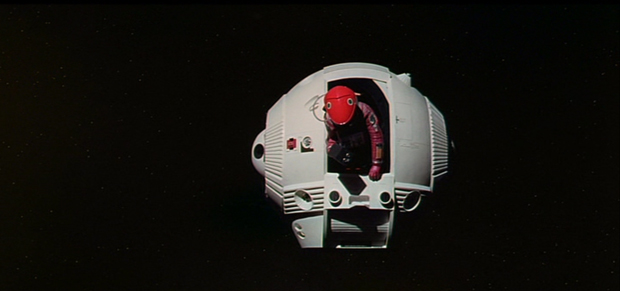
Kubrick has Dave float out at a 90 degree angle from us.
310 Rear view of Dave floating toward the communication dishes. (1:16:12)
Dave's air hose is suddenly on his left and he is now carrying the box in his left hand. A horizontal flip.
311 Beyond the communication dishes now, to the left of them, distant shot of Dave floating toward them, the pod beyond. (1:16:42)
Original orientation is returned with the air hose on his right and the box in his right hand.
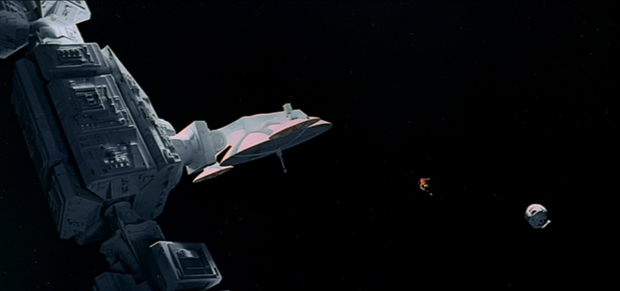
312 CU of Dave through his helmet, upside down. (1:16:58
He almost doesn't look like Dave, appearing older. He punches a button on the arm of his suit and the screen of his helmet goes black.
In section four I will discuss the ramifications of Dave darkening his sun screen.
313 Long shot of Dave next to the communication dishes. (1:17:19)
He reaches out and grabs the edge of one.
314 Poole back on the flight desk as in shot 305. (1:15:04)
315 Dave above the communications dishes, seen from below and behind. (1:17:36)
316 Medium shot of Dave, upside down, approaching the rear door of the communications dish. (1:17:43)
He begins to open it, using his right hand (on our left).
Shot 313 | Shot 314 |
 |  |
Shot 315 | Shot 316 |
 |  |
317 Long shot of Bowman opening the back of the communications dish. (1:17:58)
Bowman now switches his hands to use his left.
318 Dave viewed on the computer console opening the back. (1:18:12)
He now switches hands.
319 Poole on the flight deck as in shot 295. (1:18:16)
Shot 295 had followed the shots of Dave on the computer console entering the pod, that shot flipped horizontally. Now we have the shot of Poole again following after another shot of Dave on the computer console on the flight deck.
We've another shift back in time. For further examination on how Kubrick has made a pattern of this and how it works, see shot 294 in which I discuss this and how it happens in 293/294 and 220/221 and 167/169.
320 MS of Dave opening the back of the communications dish. (1:18:21)
He withdraws the AE35 in shots 320 and 321.
It gets blindingly tedious to explain the pattern over and over again so I won't do it here, and if you are really reading along you may be going, "What, again? Ah, c'mon, stop it." Yeah, what again, because we have not only a pattern but a pattern demonstrating itself in various ways to flesh itself out and make itself recognizable as a pattern. For instance, it's likely very few realize the few drop backs in time ever, or the horizontal flips/mirrorings. Then when you do come upon them, and start examining them, by the time you hit this one there's a sensibility to their unfolding in such a way that it is a bit like seeing the "idea" come to life with Dave being shown as exhibiting the pattern in his movements, with his simply changing hands from right to left, the mirroring aspect, horizontal flip expressed in just the human form. And then we have the 90 degree angle, diagonal demonstrated again (another part of the pattern) with the way the AE35 units are positioned, the one that Dave is removing and the one he is replacing it with. When he does this we are reminded of such shots as 288.
It's a pattern without a lot of "Wow!", a difficult one to discern sometimes even if you know its composition. It puts these idiosyncrasies--the horizontal flips etc.--sometimes in the framework of a pattern. The pattern, threaded throughout the story, is fundamental to it organizationally and philosophically, due to what the elements of the pattern represent, but absence of awareness of it doesn't harm the story for the viewer. Despite being fundamental to the story organizationally and philosophically, it is a discreet visual heiroglyph.
There reaches a point where one goes, "Is this just a tic of Kubrick's?" But we have to remember Kubrick was a chessman and that he has expressed, for instance, the 90 degree turn in chess terms such as with the knight. The blacks and whites of the chess board becomes a metaphor for dualism that is an expression of "being" rather than moral compass--a dualism in which is also expressed symmetry, and the knight is a peculiar piece. Kubrick's early Fear and Desire and his interest in twins, as seen from the beginning, in his first boxing documentary, is key to understanding his long standing interest in these themes. In Fear and Desire Kenneth Harp not only plays Lt. Corby, but also the enemy general. Steve Coit not only plays Private Fletcher, but also the enemy captain. Lt. Corby and Private Fletcher infiltrate the enemy camp, kill the general and the captain, and what do we have but the dead men looking exactly like them. In the hands of a first year film student the ideas expressed in this twinship, this dualism, would likely come off not very well. And Kubrick, as I understand it, wasn't too proud of this film. But in Fear and Desire we have ideas that Kubrick was profoundly interested in expressing and which he didn't abandon. He sublimated them, finding other ways of articulation, so the audience may not be aware of them in any overt manner and yet the absolutely form the underpinning and guiding philosophy of his films.
Kubrick made very obvious use of flipped shots in Fear and Desire. He was already doing them in his first feature, using them when he was depicting the death of the soldiers and the death of the captive girl. He toned down the flips in his later work so they don't stand out so obviously.
321 LS of Dave, from below, as he fully withdraws the AE35. (1:18:43)
322 CU of the computer scanning the AE 35 as it rotates. (1:18:48)
Shot 319 | Shot 320 |
 |  |
Shot 321 | Shot 322 |
 |  |
Screen changes to shot of the computer scanning the AE 35.
323 CU HAL's red eye. (1:19:05)
HAL's eye is still occluded as it was earlier, beginning with when he began his questioning of Dave, if he sensed any mystery in their trip.
324 Poole and Dave scanning the AE 35, as seen by HAL. (1:19:08)
325 MS of Dave and Poole from above scanning the AE 35, the map of its circuits running on one of the computer screens. (1:19:17)
326 LS of Dave and Poole from between the pods. (1:19:33)
327 CU of Dave. (1:19:39)
328 CU of Poole as Dave looks at him. (1:19:45)
329 CU of Dave as in shot 327. (1:19:47)
BOWMAN: Well, HAL, I'm damned if I can find anything wrong with it.
HAL: Yes...
330 CU of HAL's eye. (1:19:57)
HAL: ...it's puzzling. I don't think I've ever seen anything quite like this...
331 Poole and Dave as in shot 324, seen by HAL. (1:20:03)
HAL: ...before. I would recommend that we put...
332 CU Hal's red eye. (1:20:11)
HAL: ...the unit back in operation and let it fail. It should then be a simple matter to track down the cause.
333 LS of Dave and Poole from between the pods as in 326. (1:20:20)
HAL: We can certainly afford to be out of communication for the short time it will take to replace it.
Shot 326 | Shot 327 |
 |  |
Shot 328 | Shot 329 |
 |  |
Shot 330 | Shot 331 |
 |  |
Shot 332 | Shot 333 |
 |  |
AE 35 AND ITS MAZE ASPCTS
Before moving along I'd like to briefly look at some shots of the circuity of the AE35.
These are just a few examples from the circuitry. With their repetitions (and sometimes reversals) they strongly remind of the world maze in The Shining.
A puzzle of a maze.
If we return to the initial scans of the AE35 we see what could be said to resemble the monolith.
We also again find the numbers 4/5 and 3/6 (here 63) that are the ECO a35 opening chess move I've discussed earlier. And the 3/6 that is the problem of HAL's chess game, he saying that the queen was moved to Bishop 3, which was what the White player would say/perceive, when he should have said Bishop 6, which was what the Black player would say/ perceive. There are many places one could possibly perceive a hidden monolith in 2001, and this one is interesting in its relationship to the AE 35.
I should point out again that the convergences associated with the monolith's appearance, due their nature, can only be taken as symbolic. Though we may perceive them as natural physical phenomena, Kubrick makes no attempt to express them as being such.
IN ERROR
A HIDDEN CONVERGENCE AND VARIOUS ASPECTS OF TAURUS
334 Medium shot from behind Dave and Poole at the computer console as in 290, they speaking with Mission Control. (1:20:34)
MISSION CONTROL: X-RAY Delta One, this is Mission Control. Roger, you're one nine er three zero. We concur with your plan to replace number one unit to check fault prediction. We should advise you however that our preliminary findings indicate that your onboard nine er triple zero computer is in error predicting the fault.
335 Shot of Dave and Poole from the front. (1:20:54)
MISSION CONTROL: I say again, in error predicting the fault. I know this sounds rather incredible, but this conclusion is based on results from our twin nine er triple zero computer. We are skeptical ourselves and we are running crosschecking routines to determine reliability of this conclusion. Sorry about this little snag fellas, and we'll get this info to you just as soon as we work it out. X-RAY Delta One, this is Mission Control, two zero four nine er, transmission concluded.
336 Shot of Dave and Poole from the rear exactly the same as 334. (1:21:22)
HAL: I hope the two...
337 Shot of Dave and Poole from the front exactly as 335. (1:21:28)
HAL: of you are not concerned about this.
BOWMAN: No, I'm not HAL.
HAL: Are you quite sure?
BOWMAN: Yeah. I'd like to ask you a question though.
HAL: Of course.
BOWMAN: How would you account for this discrepancy between you and the twin nine thousand.
HAL: Well, I don't think there is...
338 Shot of Dave and Poole from the rear exactly as 336. (1:21:44)
HAL: ...any question about it. It can only be attributable to human error.
339 CU of Dave. (1:21:50)
HAL: This sort of thing has cropped up before...
340 CU of Poole. (1:21:54)
HAL: ...and it has always been due to human error.
POOLE: Listen, HAL. There's never been any instance at all of uh computer error occurring in the nine thousand series, has there?
HAL: None whatsovever, Frank.
341 3/4 side view from rear of Dave and Poole from the same angle as 270. (1:22:10)
HAL: The nine thousand series has a perfect operational record.
POOLE: Well, of course I know all the wonderful achievements of the nine thousand series, but are you certain there's never been even any case of the most insignificant computer error?
342 CU of HAL's red eye. (1:22:26)
HAL: None whatsoever, Frank. Quite honestly, I wouldn't...
343 CU of Poole as in 340. (1:22:30)
HAL: ...worry myself about that.
Poole looks to Dave.
344 CU of Dave looking at Poole. (1:22:34)
BOWMAN: Well, I'm sure you're right, HAL. Uh, fine. Thanks very much. Oh, Frank...
345 Shot of Dave and Poole from front as in 337. (1:22:45)
BOWMAN: I'm having a bit of trouble with my transmitter in C pod. I was wondering if you'd come down and take a look at it with me.
POOLE: Sure.
BOWMAN: See you later, HAL.
Shot 336 | Shot 337 |
 |  |
Shot 338 | Shot 339 |
 |  |
Shot 340 | Shot 341 |
 |  |
Shot 342 | Shot 343 |
 |  |
Shot 344 | Shot 345 |
 |  |
346 Unusual shot of CU of HAL's red eye. We see Dave and Poole reflected as they rise. (1:22:52)
What we are viewing is a hidden convergence. And this is possibly a "Wow!!!" if you've not noticed it before.
I had noted previously that I don't think Zoroastrianism has been symbolized in the film by the sun and crescent as the crescent is with its back to the sun. That doesn't mean that Zoroastrianism, ideas associated with it, don't appear in the film. But this crescent is consistently shown with its back to the sun, which is more akin to what we find with Taurus.
Here we finally have the crescent meeting the "sun" and the sun is contained within the red eye of HAL. Clearly we see something that is more akin to the symbol of Taurus, the bull.
Peculiar as it may seem, here is where the minotaur enters, a myth Kubrick was already expressing interest in as early as his film Killer's Kiss, and which is found in a number of his films, a notable example being The Shining with its maze.
HAL has just said "it's puzzling". Just beforehand we've been given views of the circuity of AE35 that recalls a maze and has been compared to a puzzle. The way the circuitry illuminates brings to mind the dead ends of mazes in which one has to reverse and look for another path to the center. Whereas, with a unicursal labyrinth, consistent turns and reversals are built into a path through which one is guided.
The Cretan bull is believed to have been based on Taurus (in which was the vernal equinox).
Wikipedia notes:
In the Mesopotamian Epic of Gilgamesh, one of the earliest works of literature, the goddess Ishtar sends Taurus, the Bull of Heaven, to kill Gilgamesh for spurning her advances. Gilgamesh is depicted as the neighboring constellation of Orion, and in the sky they face each other as if engaged in combat.
Taurus and the bull had a lot to do with early ideas of the vernal equinox and sacrifice and rebirth. Some more quotes from Wikipedia on this:
Taurus marked the point of vernal (spring) equinox in the Chalcolithic and the Early Bronze Age (the "Age of Taurus"), from about 4000 BC to 1690 BC, after which it moved into the neighboring constellation Aries...
In these ancient cultures, the orientation of the horns was portrayed as upward or backward. This differed from the later Greek depiction where the horns pointed forward. To the Egyptians, the constellation Taurus was a sacred bull that was associated with the renewal of life in spring. When the spring equinox entered Taurus, the constellation would become covered by the Sun in the western sky as spring began. This "sacrifice" led to the renewal of the land. To the early Hebrews, Taurus was the first constellation in their zodiac and consequently it was represented by the first letter in their alphabet, Aleph.
We have Orion being the first ship that carried Heywood from Earth. Second was Aries which carried Heywood from Space Station 5 to the moon.
This section opened with some of my thoughts on Gilgamesh being evidenced in 2001 and I need not repeat them again.
Taurus as the bull also contains the red star Aldebaran, which used to be conceived of as being evil.
Again, from Wikipedia:
When the moon has reached the constellation of Taurus, it has passed over an area that the ancients referred to as the sea - the region from Capricorn to the region containing Aries. It was referred to as the sea due to the high concentration of constellations identified as sea creatures within it, Aries being identified as a golden flying ram who flew over the sea. Crete is in a direct line from the natural harbor of Argo, a direction which due the shape of Argo's harbor, and surrounding coastline, requires that all ships initially take this course.
Apart from being a bull, Taurus contains a very bright and red star (Aldebaran), meaning that many took it to be evil. Some forms of Greek mythology associated the constellation with the tame white bull, in some versions Zeus in disguise, who seduced Europa and took her to Crete (Minos), whereas others associate it with the white bull that fathered the Minotaur.
This red star in Taurus sounds very much like HAL, but that doesn't mean Kubrick presenting evil vs. good. Despite everything HAL does, one never gets the impression that HAL is evil. For one thing, HAL isn't human. But then neither is the red star Aldebaran human.
In Judaism, Taurus is shor, the ox that "represents the spiritual origin of man's animal soul."
The month of Iyar is the month that man rectifies his animal soul, refines his innate character traits (each day of "sefirat haomer"), as he prepares to receive the Torah in Sivan. In Hebrew, the root "shor" also means to look or observe. Iyar is the month of introspection for the sake of self improvement.
Source
Taurus and its relationship to the rest of the year as expressed by the site Ohr Somayach is pretty interesting.
The cycle of the mazolot (astrological signs), is like the cycle of the life of a man: In the beginning, when he is born, Man is like a lamb (T'leh/Aries) - soft and delicate. As he grows, he becomes powerful like an ox (Shor/Taurus). Then he becomes like the twins (Teumim/Gemini): He sees himself as complete and perfect. Then his yetzer hara (negative impulse) starts to grow. At first it is as small as a crab (Sartan/Cancer), but if left unchecked, it becomes as strong as a lion (Arieh/Leo). If he sins, his yetzer hara puts on the mask of innocence, appearing as pure as a maiden (Betula/Virgo). And if he continues to transgress, he is placed in the Scales (Moznaim/Libra), and his fate is weighed in the balance. If he persists in his rebellion, he is sent down to the depths, placed in a pit like a scorpion (Akrav/Scorpio). However, if he has a change of heart and returns to G-d, he is rocketed out of the pit like an arrow from the bow (Keshet/Sagitarius). Then he is transformed, returned to his former state of innocence and becomes like a kid (G'dee/Capricorn) - purified by the waters of the water-carrier (D'lee/Aquarius). His life comes full-circle when like a fish (Dagim/Pisces), he luxuriates and basks in the water of eternity, his soul reposing in the higher world from which it came.
Source
Pesach Shani is the second passover and occurs one month after Passover, in the month of Iyaar, Taurus. Its purpose "was for those who were unable to bring the Passover sacrifice on the correct date because they were then impure or too far from Jerusalem--to have a second chance to do so." Elsewhere, I discuss at length Kubrick's expression of ideas concerning Passover/Pesach/anamnesis/ZKR and shani being found in his films. I elaborate on them throughout The Shining, but the most concentrated discussions are here and here. As far as 2001 is concerned, we need to ever keep in mind that Kubrick has brought in Passover, pesach, the paschal mystery, anamnesis etc. with his pointed use of the music of a requiem mass, and especially communion music.
THE THEME OF CRISES IN COMMUNICATION IN KUBRICK'S FILMS
347 Dave and Poole climb down into an area off the pod bay. Another HAL console is here. (1:22:58)
They enter the pod bay.
BOWMAN: Rotate C pod please, HAL.
HAL rotates the center pod. When Dave went EVA before this was B pod.
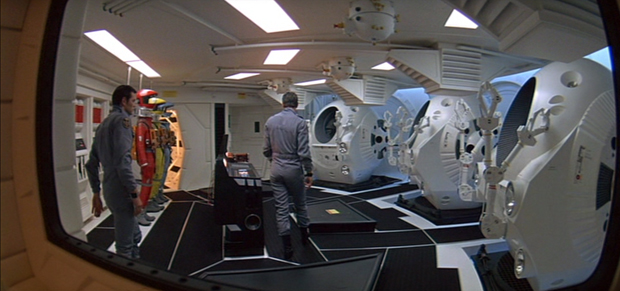
348 Opposing view of the two men in the room as the pod revolves. (1:23:21)
POOLE: What sort of trouble have you been having, Dave?
BOWMAN: I've been getting some interference in B channel.
POOLE: We'll have a look at it.
349 View of Dave and Poole from between the two pods as in 333. (1:23:32)
BOWMAN: Open the door, HAL.
A fun little thing to notice is that a reflection of wall in the blue helmet causes it to look a little like a face is hidden within it in this scene. That face is slightly reminiscent of the faces in the hibernation pods in shots 245 and 419.
350 View of Dave and Poole from between the red and yellow helmets. (1:23:41)
First Poole then Dave enters the pod.
We should look back to shots 293 in which we had Dave entering the pod, lifting his leg to form the diagonal, and then the reversal in shots 294. I've noted in my remarks there on the half red circle entering sometimes as part of a pattern and how Dave's helmet fulfills that pattern in that scene. Here, Kubrick has Poole entering the pod, his leg lifted in the diagonal, and behind him we have both the red and yellow helmets looking on. Kubrick next cuts to a shot of HAL's eye and we seem to have Dave's red suit and Frank's yellow suit referring to the red and yellow of HAL's eye.
Shot 349 | Shot 350 |
 |  |
351 CU of HAL's red eye. (1:23:49)
352 CU of the back of the pod closing (1:23:53)
We see CAUTION EXPLOSIVE BOLTS and maintenance and replacement instructions.
353 MS of the computer console from beside the C pod.
(1:23:59)
BOWMAN: Rotate pod, please, HAL.
The pod rotates.
354 Side view of room with the pod rotating as in 348. (1:24:06)
BOWMAN: Stop pod rotation, please, HAL.
The rotation stops.
Shot 352 | Shot 353 |
 |  |
Shot 354 | |
 | |
355 Controls inside the pod. A hand reaches over and flips them. (1:24:23)
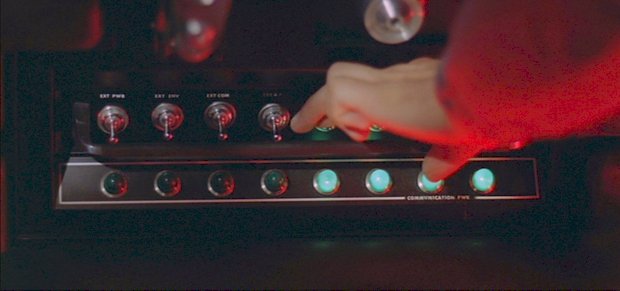
You will notice the deep green of the lights that appears as Dave flips the switches off, cutting off communication with HAL and isolating them from him, or so he imagines. I've noted how green is a color that doesn't make an appearance in the film except for a couple of times. The helmet Dave wears when he has blasted his way back onto Discovery One and walks through the ship to the brain center to disable HAL's memory is deep green.
Dave's sleeve is colored here so that it looks much like he is in his red atmospheric suit rather than his blue-gray uniform.
356 Poole and Dave inside the pod, the camera facing HAL. (1:24:23)
BOWMAN: Rotate the pod, please, HAL. (No response.) Rotate the pod, please, HAL. (No response.) I don't think he can hear us.
POOLE (louder): Rotate the pod, please, HAL. (No response.) Yeah, I'm sure we're okay. Well, what do you think?
BOWMAN: I'm not sure. What do you think?
POOLE: I've got a bad feeling about him.
BOWMAN: You do.
POOLE: Yeah. Definitely. Don't you?
BOWMAN: I don't know. I think so. You know, of course, he's right about the nine thousand series having a perfect operational record. They do.
POOLE: Unfortunately, that sounds a little like famous last words.
BOWMAN: Yeah, still it was his idea to carry out the failure mode analysis, wasn't it? Should certainly indicate his integrity and self confidence. If he were wrong it would be the surest way of proving it.
POOLE: It would be if he knew he was wrong. Look, Dave, I can't put my finger on it but I stress something strange about him.
BOWMAN: Still, I can't think of a good reason not to put back the number one unit and carry on with the failure mode analysis.
POOLE: No. No, I agree about that.
BOWMAN: Well, let's get on with it.
POOLE: Okay. But look, Dave. Let's say we put the unit back and it doesn't fail. That would pretty well wrap it up as far as HAL was concerned, wouldn't it?
BOWMAN: Well, we'd be in very serious trouble.
POOLE: We would, wouldn't we? What the hell could we do?
BOWMAN: Well, we wouldn't have too many alternatives.
POOLE: I don't think we'd have any alternatives. There's not a single aspect of ship operations that isn't under his control. If he were proven to be malfunctioning, I don't see how we'd have any choice but disconnection.
BOWMAN: I'm afraid I agree with you.
POOLE: There'd be nothing else to do.
BOWMAN: It would be a bit tricky.
357 Shot of HAL through the door, not including Dave and Poole. (1:26:22)
BOWMAN: We'd have to cut his higher brain functions. Without disturbing the purely automatic and regulatory systems. And we'd have to work out the transfer procedures of continuing the mission under ground based computer control.
358 Return to shot as 356 of Dave and Poole. (1:26:38)
POOLE: Yeah. Well, that's fair safer than letting HAL continue running things.
BOWMAN: You know, another thing just occurred to me. Well, as far as I know, no nine thousand computer has ever been disconnected.
POOLE: No nine thousand computer has ever fouled up before.
BOWMAN: That's not what I mean. Well, I'm not so sure what he'd think about it.
Shot 357 | Shot 358 |
 |  |
359 CU of HAL's red eye. (1:26:58)
HAL's eye remains occluded.
360 CU vignetted shot of Poole's lips as he speaks. (1:27:02)
Pan over to Dave's lips speaking. Pan back to Poole's lips responding. Pan back to Dave speaking.
In both 2001 and The Shining we have this idea of communication being cut off. In some respects what is less remarkable to me than the idea of the imminent failure of the AE35 unit, especially when they have a back-up, is HAL's insistence that, "We can certainly afford to be out of communication for the short time it will take to replace it." In The Shining we have the prospect of doom hanging over the scene from the beginning, due Danny's vision and our knowledge of Jack's abuse, but it is the threat of isolation that increases anxiety for them, and it is when the Overlook is cut off by the snow storm and lines of communication are down, except the radio, that events escalate. Finally, Jack disables the radio. Again, with Dr. Strangelove, it is the destruction of radio equipment, the CRM-114 Discriminator, that isolates the bomber from receiving the recall code that would stop the dropping of the bomb. It seems to me a really strategic scene in 2001 concerning communication is this one, in which we see Dave cutting off communication to HAL in the pod and Dave and Frank believing they are having their conversation isolated from HAL.
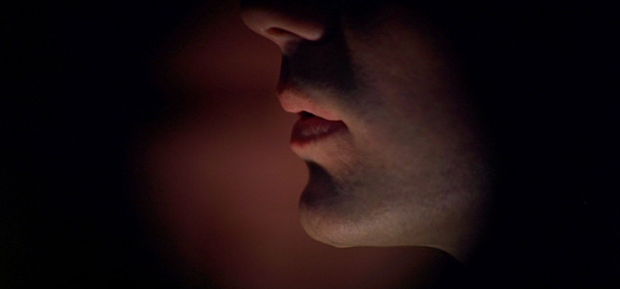
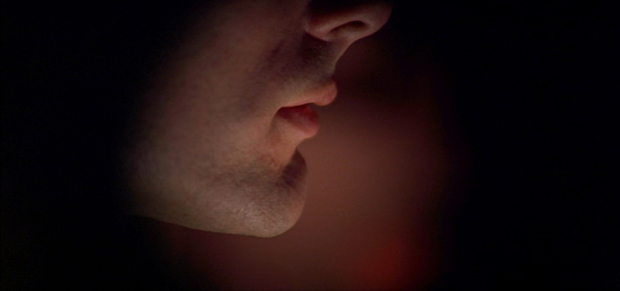
This scene is replayed in Eyes Wide Shut when Bill is with the prostitute, Domino. First, she declines to discuss specifics, saying that she would prefer to not put things into words, and, as with the hibernators and sleepers who have no sense of time, she remarks she won't keep track of time. After she remarks she doesn't keep track of time, Kubrick cuts to the CU shot of their profiles as they gaze at one another, and it is much like the shots here of Dave and Poole. Just as they are about to kiss, the phone rings, interrupting them. It's Alice calling to find out where Bill is, as if she has a sixth sense, and, indeed, in a way she does, for the film she is watching on television is about a man who cheats on his wife.
You'll notice that the final shot before intermission is shot 360. I had originally thought to include the intro and intermission music as shots and due this I made the intro music 0 rather than 1, figuring that Kubrick had intended this shot to be 360 so we have a full 360 degrees completed from the beginning. And then there was the puzzle of shots 105 and 105a in which the bone is thrown into the air, and in which we have actually two shots. But I feel that we are supposed to view them as one shot, if only for philosophical purposes, and viewing them as one shot instead of two also means we have 360 shots before intermission, otherwise we should have to go to 361. Certainly, however, Kubrick intends this section to end on shot 360 so that we have the full circumnabulation of a circle.
We are, at this point in the film, where we were when Bill visits the end of the rainbow and Somerton in Eyes Wide Shut. With A Clockwork Orange, the corresponding point in that film is Alex having undergone the Ludovico technique. It is at those points in the film that we have reached a kind of center (as in the center of a maze, thus the Taurus symbol fully realized in shot 346) and the main character then in the second portion of the film revisits situations and scenes from the first part of the film. Just as we are about to do the same here.
HAL'S ERROR
For more on the function of the "error" in Kubrick's films, which we observe from Fear and Desire on, read the post STANLEY KUBRICK'S FEAR AND DESIRE, THE TEMPEST, COMUS, CHESS AND HAL'S ERROR. A glaring mistake concerning The Tempest occurs in Fear and Desire and merits examination. How Kubrick incorporates the chess game into Sidney's "error" when relating Ariel's story. How this relates to HAL's error. How chess is expressed through a hidden 64 in Fear and Desire, which uses as its template a hidden 64 in The Tempest.
tl;dr. What happened? Keep it short because my three seconds dedicated to perusing this page are almost up and there are pics of cats out there by which to be entertained.
The two marvelous convergences in the two prior sections didn't physically happen. Here we have another convergence that does happen but is discreet and goes unnoticed by the audience. And it concerns HAL.
June 2014. Approx 19,500 words or 39 single-spaced pages. A 150 minute read at 130 wpm.
Return to the top of the page.
Next: Part four
Return to Table of Contents for "2001: A Space Odyssey" analysis
Link to the main film page for all the analyses

